
“It’s always been a priority to hire people of color, so our young people will have that role model in the district.”


“It’s always been a priority to hire people of color, so our young people will have that role model in the district.”
A
Katrina Farmer is the new vice president of Diversity, Inclusion and Equity for Barnes-Jewish Hospital and St. Louis Children’s Hospital.

Attorney Dedra Brock of Brown & James – and East St. Louis
By Rebecca S.Rivas Of The St.Louis American
Growing up in East St. Louis,
attorney Dedra Brock realized that too often people in her community didn’t have a voice – but attorneys did. So at age six, she made up her mind to become a lawyer.

Inclusion is Otis Scott’s job as regional human resources director
Scott oversees 30,000 hourly workers and 5,000 managers in more than 130 stores.He spends a lot more time working on strategy.
~ Page 6 ~ Diversity Hall of Famer
By Sandra Jordan Of The St.Louis American
“This is a business of taking care of patients and providing them with the care they need.”
On naming the Stan Musial Veterans Memorial Bridge
In his own quiet but determined way,Stan Musial was also on the vanguard of fighting discrimination and changing America.
~ Page 3 ~

Before she left St. Louis and Barnes–Jewish Hospital, Brenda Battle – then director of the Center for Diversity and Cultural Competence at BJH – was fighting for inclusion to be represented at the table where decisions about the business of health care take place. That position of influence and
American staff
St. Louis Community College ranks among the top 100 institutions in the number of associate degrees conferred to African-American students, according to information published in Diverse Issues in Higher Education magazine. STLCC ranked 36th in the number of associate degrees conferred to African-American students in 201112. The University of Phoenix-Online (Ariz.) was ranked first. STLCC was the only Missouri community college to make the list. The rankings are based on the review of 2011-12 preliminary data submitted by institutions to the U.S. Department of Education’s National Center for Education
– Katrina Farmer,VP Diversity,Inclusion and Equity for BJH and Children’s hospitals
~ Page 25 ~ Diversity at Walmart BJH and St. Louis Children’s hospitals.
prominence for diversity was what attracted Katrina Farmer to the newly created position of vice president of Diversity, Inclusion and Equity for
“You can either stay where are and be depressed, or go where you are going and deal with the challenges.”
– Dedra Brock
“I remember thinking that I needed to become an attorney so I could help my community –that was my position,” said Brock, an associate at Brown & James law firm. “I had great teachers, and they supported my dream.” However, Brock’s dreams had to wait when she became a single teenage mother. While other girls were going to parties or leaving for college after high school, she was learning the hard lessons of being a mom, she said.
“It was a lot of hard work and sacrifice,” she said. “But you can either stay where are and be depressed, or go where you are going and deal with the challenges.”
For many years she worked at Ameren in the meter department, the call center and with fleet services to support her two daughters. At 28, she finally saved up enough money to

St.Louis Community College student celebrate at their 2012 graduation ceremony. St.Louis Community College conferred 474 associate degrees to AfricanAmerican students in 2011-12, accounting for 22 percent of the degrees conferred during that academic year.
American staff
E’Little Media Group is full-service advertising, public relations and marketing agency located in the Central West End.
“We make a science out of understanding a client’s unique brand,” said Johnny Little Jr., president.
“By coupling grassroots, in-thetrenches, hard work with today’s latest global marketing tools, E’Little launches ideas, build awareness and creates brand names.”
“We make a science out of understanding a client’s unique brand.” – Johnny Little Jr.
E’Little Media Group’s staff includes, former KSDK, channel 5 news anchor Jeff Small and former Ladue School District director of communications Kathy Reznikov.
“We work hard to deliver the best plan for your businesses, even if it means becoming a morning person, drinking entirely too much coffee, and eating meals in cars,” Little said.
“We do this because we believe in the work that we do for others. And we know that the greatest reward for our work is a job well done.”
Prior to starting E’Little Media Group, Little served as director of communications for St. Louis Public Schools district.
He has two local firsts in broadcast journalism. He served as the first African-American executive news producer for KMOV, Channel 4, from 2002 in 2005. From 1996 until 2002.
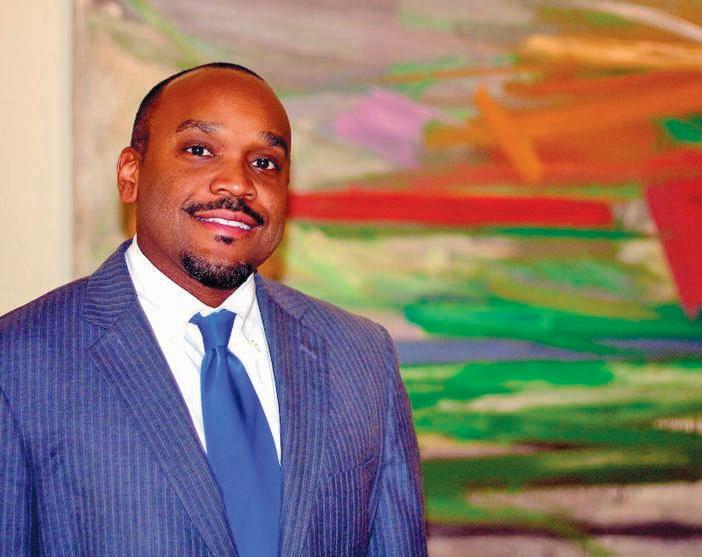

Workforce diversity doesn’t just happen. It takes a commitment and persistence. And, the commitment starts at the top of the organization. Here’s what local leaders have said regarding diversity and inclusion and their importance for the benefit of the entire region:
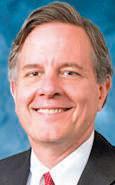
“Diversity starts at the top. It used to be that we would look at diversity as something separate. Now it is integrated into every decision we make at the firm. Every time we talk about a topic, it includes diversity in that lens.”
Danny Ludeman President and CEO Wells Fargo Advisors

“If you have people from different backgrounds and different cultural experiences and they are organized around a common objective, they are far more likely to create breakthrough innovation than a homogenous group. At the board level, the same is true. That same diversity of thinking is a powerful advantage.”
Arnold Donald CEO Carnival Corporation

“You really need to dig in the data and make sure you’re diverse on a macro level and reflective of the community. When the board hired me, they made sure I understood diversity was a priority at Laclede Gas. We had many conversations about how to put inclusion at the forefront.”
Suzanne Sitherwood President and CEO The Laclede Group

“We operate in a talentdriven economy. To the extent that we are able to welcome and include people from all over the world and every neighborhood in our region – if we do that, we will be a success. If we don’t, we are chasing off the resources that are the keys to our economic success.”
Joe Reagan President and CEO St. Louis Regional Chamber

“Inclusion is necessary for the social and economic health of any community. Inclusion results from Effective and Diverse Leadership. However true Diversity is meaningless without Inclusion; and Inclusion only has meaning when it is part of the natural course of business. Inclusion can’t be an afterthought, otherwise it is just a PR stunt.”
Nicole Adewale Principal and President ABNAEngineering
By U.S.Rep. Wm.Lacy Clay
For The St.Louis American
I was very pleased to cosponsor H.R. 2383, bipartisan legislation just approved by Congress that designates the new Interstate-70 bridge over the Mississippi River connecting the City of St. Louis and southwestern Illinois as the Stan Musial Veterans Memorial Bridge.
As the U.S. Representative who has the honor of representing the St. Louis Cardinals, it is a special privilege for me to speak about Stan Musial from the perspective of a Member of Congress, and also from the memory of a young boy at old Sportsmen’s Park with my dad, former Congressman Bill Clay, as we watched Stan play near the end of his remarkable career. Stan Musial was simply one of the greatest baseball players of all time. In 22 seasons with the St. Louis Cardinals, he helped them win three world championships. He won seven national league batting titles, three most valuable player awards, and at the time of his retirement in 1963 Stan Musial held 17 individual major league baseball records. He was elected to baseball’s Hall of Fame on the first ballot. What is less known is that as good a player as he was on the field; Stan Musial was even a better man off the field. In his own quiet but determined way, Stan Musial was also on the vanguard of fighting discrimination and changing America. Stan was born in the small town of Donora, Pennsylvania, the fifth of five children.
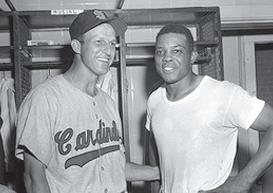
Donora is also the hometown of baseball’s famous Griffey family.
As a young man, Stan was no stranger to the challenges of African Americans and the evils of segregation.
When their high school team was supposed to have dinner in a segregated hotel, Stan Musial and the rest of the team walked out.
Years before the desegregation of baseball in 1947, Stan, a gifted athlete, was playing basketball with Buddy Griffey, the father of the great Ken Griffey Sr. and the grandfather of the great Ken Griffey Jr. When their high school team was supposed to have dinner in a segregated hotel,
Stan and the rest of the team walked out.
In 1947, six years after Stan was called up to the Cardinals, Jackie Robinson broke the color barrier with the Brooklyn Dodgers.
Many more great black and Latino players would follow. They faced racial taunts and threats on an almost daily basis – sometimes from the fans in the stands, sometimes from the opposing team, and sadly, sometimes from their own teammates.
When some white players on the St. Louis Cardinals threatened to boycott the game if they were forced to play with blacks, Musial stood tall for justice and stopped the boycott before it started.
When Stan died, stories from those difficult days were told with great reverence and respect. Upon hearing of his death, Hall of Famer Willie
See MUSIAL, page 13
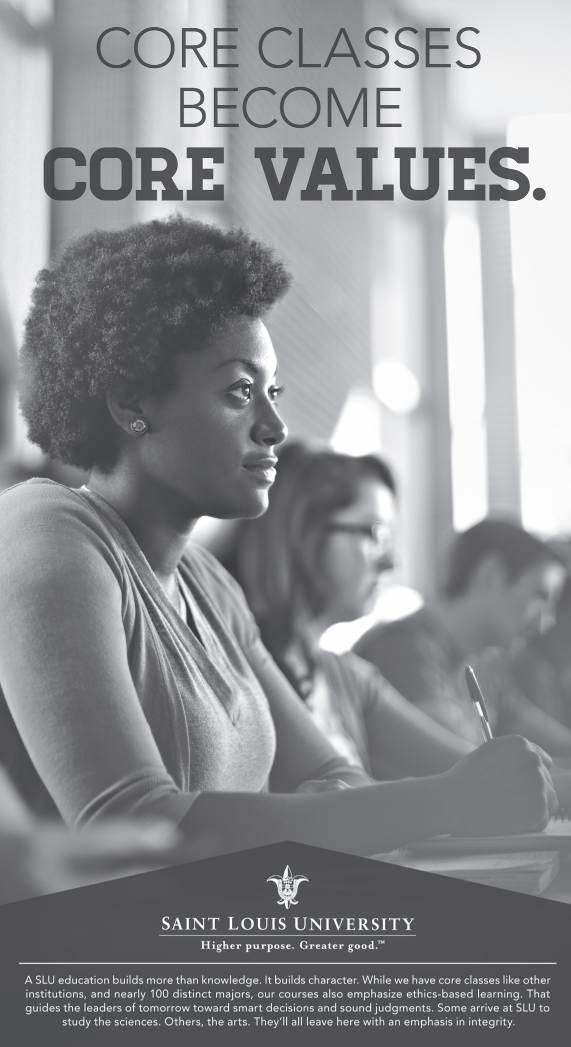


American staff
Three doctoral candidates at Washington University in St. Louis were inducted into the Edward A. Bouchet Graduate Honor Society at the annual Bouchet Conference on Diversity in Graduate Education April 19-20 at Yale University.
Inducted as the seventh class of WUSTLBouchet Fellows are Stephanie N. Rodriguez, a doctoral candidate in the immunology program in the Division of Biology and Biomedical Sciences; Beverly A. Tsacoyianis, a doctoral candidate in the Department of History in Arts & Sciences; and Sha-Lai L. Williams, who was conferred a PhD from the Brown School during the university’s May 17 Commencement.
The Bouchet Society, named for the first African American to earn a doctorate in the United States, recognizes outstanding scholarly achievement and promotes diversity and excellence in doctoral education and the professoriate.
Rafia Zafar, PhD, associate dean for diversity and inclusiveness in the Graduate School of Arts & Sciences, coordinates the WUSTLchapter of the Bouchet Society.
“Our Bouchet honorees take their place among the ranks of the highest achieving doctoral candidates in the nation,” Zafar said. Rodriguez, who works in
the laboratory of Paul M. Allen, PhD, the Robert L. Kroc Professor of Pathology and Immunology, studies the intricate mechanisms of Tcell development and how these important immune cells mediate protection to pathogens.
Using a novel CD4 Tcell system unique to Allen’s laboratory, her dissertation work investigates the dependence of CD4 Tcells on self-molecules for their development into functionally mature and selftolerant mediators of immune protection, and for continued survival in this mature state.
Her research will address longstanding questions in the field of CD4 Tcell development, including the timing, number and duration of immature Tcell interactions with cells presenting self-molecules, as well as directly assessing the controversial role of selfmolecules in the maintenance of mature CD4 Tcells.
The recipient of a National Science Foundation Graduate Research Fellowship, Rodriguez has co-authored an article in the Journal of Immunology
She is director of WUSTL’s Young Scientist Program, which was created in 1991 by medical and graduate students to attract high school students from disadvantaged backgrounds into scientific careers through activities emphasizing hands-on research and interaction between young people and scientists. She has been involved with the organization since 2009 when she joined as
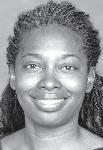


a mentor and tutor.
Rodriguez earned a bachelor’s degree in biology with honors in microbes and immunity from Stanford University in 2009.
Tsacoyianis, a Chancellor’s Graduate Fellow, is completing her dissertation, “Making Healthy Minds and Bodies in Syria, 19031961.”
She studies the social and medical history of mental illness in 20th-century Syria, arguing that psychiatrists in Syria presented mental health treatment to Syrians as more than a way to control or cure mental illness, but as a modernizing worldview to suppress and delegitimize spirit-based vernacular treatment. Her work contributes to
Contributors to Diversity:A Business Imperative
Donald M. SuggsPublisher & Executive Editor
Kevin Jones - Sr. Vice Pres. & COO
Editorial
Chris King - Managing Editor
Sandra Jordan - Health Reporter
Rebecca S. Rivas - Staff Reporter
Bridjes O’Neil - Staff Reporter
Wiley Price - Photojournalist
Sales / Marketing
Onye Hollomon - Sr. Acct. Exec.
Barbara Sills - Sr. Acct. Exec.
Pam Simmons - Sr. Acct. Exec.
Nevida Medina - Classified Ad Mgr
Production
Mike Terhaar - Art Director
Melvin Moore - Graphic Designer
Angelita F. Jackson - Graphic Artist
Administration
Robin Britt - Controller
Ishmael Sistrunk - Web/IT/Promotions Coordinator
Kate Daniel - Exec. Assistant
Loistine McGhee - Acct. Assistant
Mary Winbush - Receptionist
The St. Louis American 4242 Lindell Blvd. St. Louis, MO 63108
314-533-8000
Fax: 314-533-2332
www.stlamerican.com
scholarly debates in the history of medicine, particularly in the role of religion and science in healing, and debates about the role of the state and various non-state actors in preserving health and shaping the bodies and minds of citizens.
Sha-Lai L. Williams’ dissertation, “Mental Health Service Utilization Rates Among African-American Emerging Adults,” draws on her research in cultural competence in social work.
Tsacoyianis has received numerous honors, including a Fulbright-Hays Doctoral Dissertation Research Abroad fellowship and a P.E.O. Scholar award. She is the book review editor for the Syrian Studies Association, an interdisciplinary, international organization, and speaks and reads multiple languages, including Spanish, French, Hebrew and Arabic. Through the IIE Scholar Rescue Fund, she also has actively worked to secure safe
academic positions for international scholars at risk for discrimination and/or political unrest in their home countries.
Tsacoyianis earned a bachelor’s degree in Near Eastern and Judaic studies with a minor in Islamic and Middle Eastern studies from Brandeis University in 2004. She will start a tenure-track position in Middle Eastern history at the University of Memphis this fall after earning a doctorate in August.
Williams earned a bachelor’s of social work in 1995 from North Carolina State University and a master’s of social work in 1996 from the University of North Carolina at Chapel Hill. She was a licensed clinical social worker for more than 10 years and a supervisor to provisionally licensed clinical social workers in North Carolina for three years.
Her dissertation, “Mental Health Service Utilization Rates Among AfricanAmerican Emerging Adults,” draws on her research in cultural competence among social work and helping professionals and racial/ethnic disparities in access to and use of quality mental health services.
AChancellor’s Graduate Fellow, Williams also has received a pre-doctoral fellowship from the National Institute of Mental Health under the auspices of its training grant program. She has co-authored articles in Perspectives on Social Work, Health Promotion
Practice and Patient Education and Counseling.
Williams, an ordained evangelist, has volunteered as a youth and young adult counselor with the New Destiny Apostolic Church in Maplewood, Mo., since 2009. She will join the School of Social Work at the University of Missouri-St Louis as a tenure-track assistant professor in the fall.
Yale and Howard universities established the Bouchet Society in 2005 to recognize the life and academic contributions of Edward Alexander Bouchet, the first African American to earn a doctorate from an American university. Bouchet was the sixth person in the Western Hemisphere to be awarded the PhD in physics, which he earned from Yale in 1876. He also earned an undergraduate degree from Yale in 1874 and was elected to Phi Beta Kappa.
WUSTLwas invited to become a Bouchet chapter member in 2007, joining Georgetown and Cornell universities and the universities of Michigan and Washington, among other peer institutions.
AWUSTLcommittee selected the university’s latest class of Bouchet Fellows. Members of the committee are: Zafar; Adrienne D. Davis, JD, vice provost and the William M. Van Cleve Professor of Law; and Elaine P. Berland, PhD, associate dean of the Graduate School of Arts & Sciences and director of the Liberman Graduate Center.
ABNAEngineering
Ameren
American Eagle Credit
Armstrong Teasdale
Assoc. General Contractors
AT&T
Bank of America
Barnes-Jewish Hospital
BJC Health Care
Boeing Brown Shoe
Bryan Cave
BWTP
Centene
Covidien
Delmar Gardens
Dot Foods
Eagle Bank & Trust
Edward Jones
E’Little Communications
Emerson
Energizer
Enterprise Bank & Trust
Express Scripts
Federal Reserve Bank
Fontbonne University
Goldfarb School of Nursing
Grey Eagle
Harris Stowe State Univ.
Heartland Bank
HOK
Panera Bread Co. People’s Health Center Personal Touches By Jeanetta
Productions
By Gloria J. Browne-Marshall
For The St.Louis American
When U.S. Supreme Court

Chief Justice Roberts read the decision in the Shelby County voting rights case, the courtroom was graveyard silent. He spoke of the lives lostand brutal injusticesthat led to the passage of the Voting Rights Act of 1965. However, the country had changed, he said. Congress was wrong to re-authorize these voting protections in 2006. Section 5 of the Act, the part which requires many Southern states to seek preclearance from the U.S. Attorney General based on a certain formula, he said, was wrong. The formula was old. Congress must start over with a new formula. The chances of this happening are nearly nonexistent.
Given the past failures of a conflictedCongress, the Court hadtorn awaythe most powerful part of the Act and left a battered shell fora distracted Congress toretrofit.The same Congress unable to complete its ownagenda has been told to pass voting legislation only passed in 1965 because people were dying just to vote. Like so many listening that day, my sense ofdoom grew with each word.Despite 15,000 pages of evidence that people of color still needed to

be protected, a 5-4 majority believed people of color must once again prove their vulnerability to racism, bigotry, and the machinations of majority politics. Now, expensive lawsuits must be brought to prove harm aftera stolenelection is over. Before, under Section 5, the burden was on the local government to prove voting changes wereharmless.
Justice Clarence Thomas wrote that he would completely abolish all of Section 5, not just the formula pertaining to certain states. Then again, Justice Thomasdescribedaffirmative action asinsidious and racial engineering.To him,black and Hispanic student achievement are harmed by affirmative action policies like those in thecaseof Fisher v. University of Texas Abigail Fisher challenged her denial of admission to the University of Texas-Austin as race discrimination. Although the school takes into account a number of factors, including race, Fisher claims it was only her race that prevented admission.
Although Texas created its admissions’policy based squarely on compliance with an earlier Michigan ruling, this recent Texas decision once again places affirmative action in jeopardy.
In that early Michigan case, a white applicant, Barbara Grutter claimed she was denied admission to University of Michigan’s law school due to her race. The Court in Grutter v. Bollinger ruled race could be part of admissions, as long as it was only a part.
So, Texas used race as a part and not the sole reason. Texas allows the top 10 percent of all high school students to attend the college. Then, those not admitted into the top 10 percent may be selected based on personal factors, such as whether the applicant is an immigrant or a child of a single parent or poor or a person of color. Race is only one part. However, now race as only one factor may be unconstitutional. The Court’s Fisher
decision is disappointing. But, it’s not an outright disaster. The lower court is supposed to review the case and decide if there is any other workable alternative that creates diversity on campus without involving race.
Certainly, this non-race admissions policy may be challenged as some clandestine affirmative action. Either way, questions emerge. How many students of color are needed to provide diversity? Since the Court allows affirmative action in order to bring diversity to the education of white students, then students of color are playing a precarious role. Universities are expected to fix a festering race discrimination problem without using the word “race.”
In the midst of this struggle, admissions officers are called benign slave-holders by Justice Thomas. He would dismantle all affirmative action programs. Comparing it to slavery and Jim Crow-era segregation, this beneficiary of affirmative action believes it as harmful to blacks and Hispanics as slavery.
Ironically, affirmative action, which benefited Justice Thomas, has given him the power to end it forever. It is also ironic that the Equal Protection clause, which was enacted solely for African Americans, is now used against them. Diversity, which was meant to focus on people of color, is now meant to benefit the education of white students.
Gloria J. Browne-Marshall is a legal correspondent covering the U.S. Supreme Court. She is an associate professor of Constitutional Law at John Jay College in New York City and author of “Race, Law, and American Society: 1607 to Present.” Follow her on Twitter @GBrowneMarshall.
Inexorable demographic shifts, speedy advances in technology and communications, and rapid globalization means that increasingly, diversity is a driver of growth that must be embraced if St. Louis is to be successful as a region.
Washington University chancellor Mark S. Wrighton says “ours will only be the best climate for social, emotional and intellectual growth and achievement if we are all committed to diversity and inclusiveness.”

Donald M. Suggs, St.Louis American president, publisher and executive editor
Hugh Grant, president and CEO of Monsanto states “diversity must be ingrained into the very fabric of our company.”
For St. Louis to continue to attract and retain qualified minority job candidates and minorityowned businesses, more must be done to push for meaningful diversity and inclusion. In this competitive global age, St. Louis must do more to become a stalwart supporter of diversity at all levels in the eyes of minorities, for the benefit of the entire region. Abusiness leader, Enterprise Rent-A-Car chairman and CEO Andy Taylor says, “It’s very important that the community itself be the kind of place that is appealing to talented people of all backgrounds.”
The St. Louis American is proud to make this sev-
enth annual special section, “Diversity, ABusiness Imperative,” available for the St. Louis community. This section is designed to emphasize commitment and highlight “progress” in varied areas of diversity in our region. While we realize the region has a long way to go to reach more substantive levels of diversity and inclusion, we feel it is important to share positive information about individuals, businesses, and other organizations who do, in fact, accept and act on the belief that diversity is a vital imperative. We strongly urge your organization to partner with effective professional organizations such as the St. Louis Minority Business Council and the St. Louis Business Diversity Initiative, as we do. They represent excellent local resources to better educate members of your organization on the ongoing importance of inclusion and diversity. At the St. Louis American, not only are we a strong advocate for businesses and organizations to include diversity and inclusion in their business practices, the American also practices what we preach. We embrace diversity at every level of our organization, including employees, freelancers, columnists, drivers, managers, including senior management as well as outside vendors.

By Rebecca S.Rivas Of The St.Louis American
One day Karen I. Hall, superintendent of MaplewoodRichmond Heights School District, was looking at her son’s class picture at MRH Elementary School. She saw that 50 percent of his class is AfricanAmerican.

“It’s always been a priority to hire people of color, so our young people will have that role model in the district.”
–Superintendent
“And I thought that is a wonderful opportunity to grow up with that 50/50 split, because I’ve never had that,” said Hall, who grew up in the northern section of Webster Groves.
It’s been about a year since Hall became the district’s superintendent. The district has 1,088 students and 34 percent are AfricanAmerican, according to state statistics. Hall said the students are diverse in race as well as socio-economic status. However, about 10 percent of faculty members are people of color.
“It’s always been a priority to hire people of color, so our young people will have that role model in the district,” Hall said. “I know all the school districts are trying to make that a priority.”

The district has a natural diversity in its student population stemming from the community, and teachers try to highlight that in their lesson plans, she said.
“We support that by integrating into our curriculum social justice issues, dealing
with issues of race and things of that nature,” she said.
“We’ve had social-justice training with those integrations in the curriculum. When we hire teachers, we also talk about that. It’s a natural flow.”
The district’s dropout rate is less than one percent. Hall said
their size helps them catch struggling students before they become dropouts.
The district also established a nonprofit program six years ago called Joe’s Place, which is a house for homeless boys in the district. Of the 20 boys who have gone through the
program, all of them have gone onto college or the military, and 99 percent of them were African-American.
“Because we are so small we’re able to develop real authentic relationships with all of our students,” Hall said.
“And when you are talking
about students that may be on the radar for not graduating, we can specifically wrap around that student and their family.”
Hall came to MaplewoodRichmond Heights almost five years ago from the Pattonville School District, where she served as principal. Hall replaced the now-retired Linda Henke, who spent 12 years taking a district that was about to lose its full accreditation to becoming a district that has earned the highest points possible – 14 points – on the state’s annual performance report three times in a row.
Thirteen years ago, the district was struggling. At that time, teachers and community members said they wanted different and more innovative curriculum. Hall feels that they’ve received it.
“Our teachers write the curriculum,” she said. “They are very strong in the area of pedagogy, and we support them with that.”
The programming is also unique because it focuses on sustainability and technology. Hall feels her role is to ensure educational equity, excellence and provide strong structures. The district’s parent and community engagement has also been critical to its transformation.
“Everyone loves the programming that we have and our approach to educating young people,” she said, “and I just want to ensure that it’s sustained.”
Hall said she is from a family of many educators, and she has worked in education for her entire adult career.
“It seemed like a natural choice for me,” she said. “I’ve had many wonderful role models.”
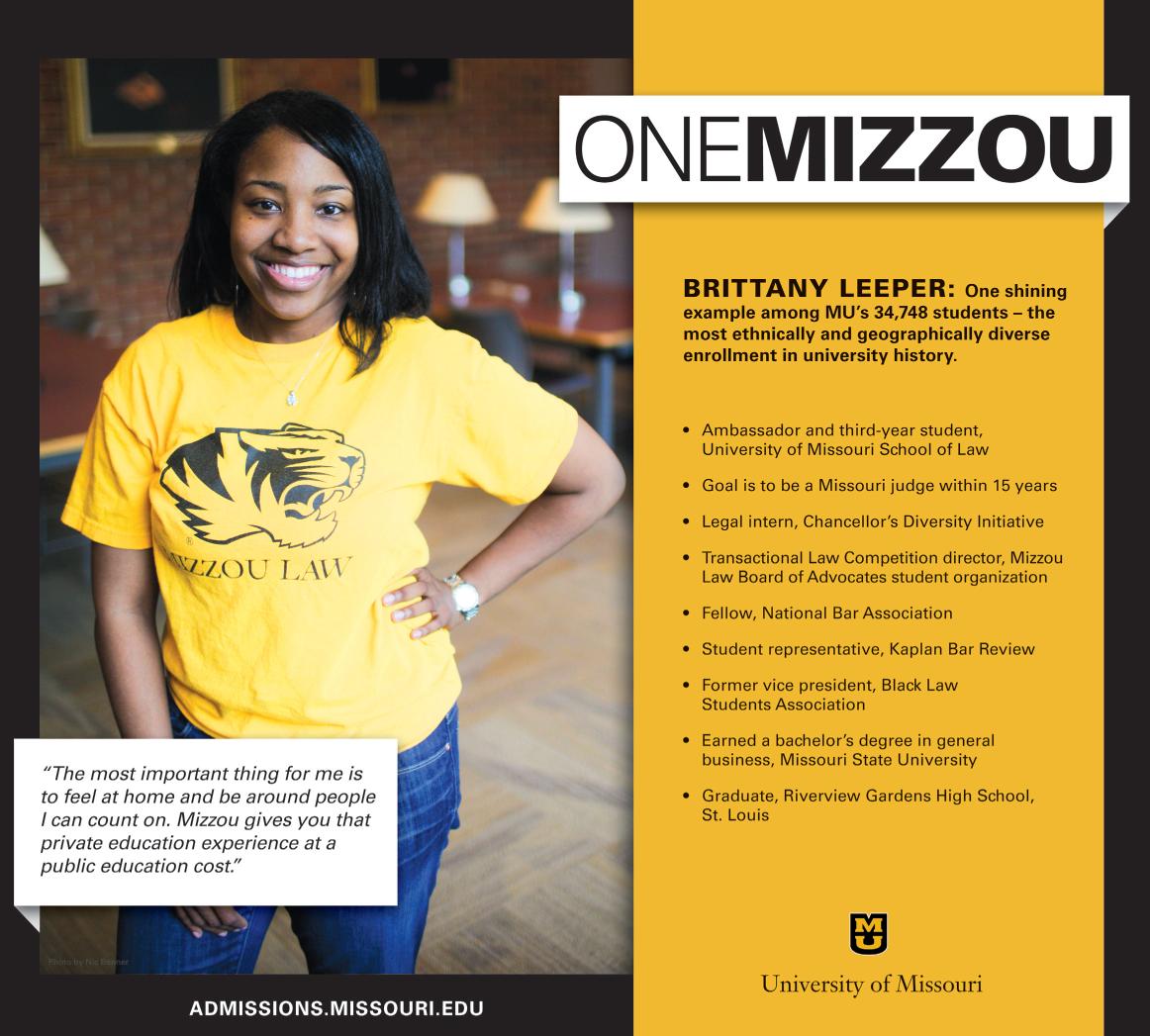
American Staff
S.M. Wilson & Co. continues its support of Construction Careers Center (CCC), a charter high school founded in September 2001 by the Associated General Contractors of St. Louis (AGC-St. Louis).
Scott Wilson, CEO of S.M. Wilson, works one-on-one with students at CCC in a mentoring role, and through internship opportunities he provides students with hands-onexperience.
“There are not a lot of young people at any school – whether you’re in Soldan or St.Charles High School –who look at construction as the first career of choice.”
– Len Toenjes
“We take pride in building the future of our community,” Wilson said. For over 20 years, S.M. Wilson has been an active member of the AGC-St. Louis. The AGC-St. Louisrepresents over 400 commercial, industrial, heavy and highway contractors, industry partners and related firms in St. Louis City and County as well as the metropolitan counties of St. Charles, Franklin, Lincoln, Jefferson and Warren and 16 additional counties along the eastern Missouri border.

The following AGC-STL contractor members have served as past and present CCC Board members: Nicole Adewale of ABNA Engineering, Paul Shaughnessy of BSI Constructors, Zachary Hamilton of Kwame Building Group, Inc., John Costello of CK Power, Chris Nisbet of McCarthy Building Companies, Ron Unterreiner of Rhodey Construction, Inc., and Tripp Zumwalt of Zumwalt Corporation. In 2009, Scott Wilson
served as chairman on the AGC-STLBoard of Directors. As chairman, Wilson was instrumental in the formation of a diversity and inclusion department within the AGCSTL.
“Scott was a one-man campaign who pled the case internally and was successful,”
Leonard Toenjes, president of AGC-STL, said of the diversi-
ty and inclusion department. Steve Lewis serves as vice president of diversity initiatives for the association.
“That has helped us focus more aggressively on the issues that need to be addressed in the industry in that regard,” Toenjes said. Those “issues” that needed to be addressed stemmed from a construction industry that
lacked skilled diverse trade workers.
“There are not a lot of young people at any school –whether you’re in Soldan or St. Charles High School – who really look at construction as the first career of choice,” Toenjes said.
That void is being filled, to some extent, by institutions like the Construction Careers
Center, he said. Of 57 graduates from CCC, 47 percent enrolled in continuing education and 44 percent are employed in industry-related careers, according to AGCSTL’s 2012 annual report.
In December 2010, Brian Cox, CCC Class of 2006, became the first alumnus to graduate from a four-year university, earning a bachelor’s degree in construction management from SIUE. While earning his degree, Cox interned at construction firms including ABNAEngineering, SM Wilson and Cissell-Mueller, as well as MODOT.
“The CCC is a great program,” Cox said. “I wanted to be in construction since I was a little kid, and the program was a great building block in preparing me for the next level of education.”
“It’s a very positive situation for all involved,” Toenjes said.
“Filling the shortages in the local construction workforce is good for the economy, diversifying the workforce is good for the community, and providing the foundation for a future career for these kids is the biggest win of all.”
The collaboration also extends outside of the school walls to other forms of mentoring, with the intervention of Big Brothers Big Sisters of Eastern Missouri.
Mark Winschel, director of business development for S.M. Wilson & Co., said the firm and its employees have been supporting Big Brothers Big Sisters through the Construction Careers Center since its inception.
“Over the years, 21 S.M. Wilson employees have been ‘Bigs’through CCC,” Winschel said.

By Sandra Jordan Of The St.Louis American
“When you think rehab, I want you to think Rehab Institute of St. Louis,” said Jon McDowell, CEO of the facility located on Duncan, not far from Barnes-Jewish health facilities in Midtown St. Louis.
Rehab Institute is a jointly owned partnership between BJC Healthcare and HealthSouth, which is the managing partner. HealthSouth brought McDowell to St. Louis nearly two years ago as chief operating officer. He was elevated to the CEO position last year after his supervisor was promoted to become a HealthSouth regional president in charge of 17 hospitals.
pendence. “I see what we do and I see just the impact we have on people’s lives,” McDowell said. “People come here in some very debilitated states; you see them come in on stretchers and you see them walk out.
The facility has a Pals program which partners non-clinical workers with new patients for quick social visits, to see how everything is going and if there is anything the patient needs.
“The administrative route appealed to me and I took that path.”
– Jon McDowell, CEO of Rehabilitation
Institute of St.Louis
Right now, McDowell’s concern is only the one facility in St. Louis. Collaboratively with leadership, he is working toward creating an atmosphere that is patient-focused and life-transforming.
“We have to create a culture that is welcoming,” McDowell said.
The 90-bed inpatient facility cares primarily for persons who are recovering from strokes, spinal cord injuries, brain injuries, amputations and other physical and neurological conditions.
McDowell said the Institute sees about 1,900 admissions a year. Patients stay longer than they would in regular hospitals and work up to three hours daily toward regaining or relearning life skills for inde-
“I am a part of that and most of us are, senior leadership as well as people in the business office or our maintenance guy or somebody in housekeeping,” he said. “You get to see that progression. It’s just amazing to me and so gratifying to me to see that change and that progression they go through.”
And it’s a steady reminder of why they are there, and who they are there for.
McDowell grew up on a farm outside of Taft, Oklahoma. After graduating from high school, he enrolled in college as a pre-optometry major.
“I always felt like I wanted to help people and, initially, that was going to be clinically,” McDowell said. “But I soon realized that clinical and hands-on patient care was probably not my thing.”
He was smart, made good grades and was business-minded. The pre-optometry major began to see his own role in the health care field much clearer.

“The administrative route appealed to me and I took that path,” he said.
McDowell earned a bachelor’s degree in health care administration and finance from Langston University before attending the University of Oklahoma to earn his masters in health care administration.
From there he was recruited by Hospital Corporation of America (HCA) for its executive training program. “They moved me from hospital to hospital,” McDowell said.
When they sold the hospital in West Virginia where he was working, he stayed. He parted company with HCAat that point, but not before meeting Jay Grinney, the person who would eventually become his company’s leader at HealthSouth. McDowell said Grinney is a “stellar guy.”
“He’s just about the right things – extremely smart, very business-savvy, but I really felt like his heart was in the right place,” McDowell said.
“Because what we do, we take care of patients, and you
McDowell is chief executive officer of The Rehabilitation Institute of St.Louis,a partnership of BJC HealthCare and HealthSouth.
have to have a heart for taking care of patients if you are going to be in this field.”
HealthSouth, headquartered in Birmingham, Alabama, owns 101 inpatient rehab hospitals, 24 outpatient rehab clinics and 25 hospital-based home health agencies in 28 states and Puerto Rico.
It has approximately 22,000 employees, and last year the
company earned $2.2 billion in revenue.
Although questions to its headquarters regarding diversity remain unanswered, its 2012 HealthSouth annual report states “the company has no formal policy on diversity of its board nominees,” stating its Nominating/Corporate Governance Committee “does not choose solely based on the distinctive skills, perspectives and experiences that candidates diverse in gender, ethnic background, geographic origin and professional experience offer.”
This follows a statement in the report that “a diversity of skills, perspectives and experiences as represented on the board as a whole … promotes improved monitoring and evaluation of management on behalf of stockholders and produces more creative thinking and solutions.”
Grimmey’s individual objectives listed in the report include maintaining an “aggressive diversity agenda” in the recruitment, development and training of all employees.
McDowell said in his career he’s worked for more female CEOs than male CEOs.
“You should pick the person. You shouldn’t pick the gender or the race,” McDowell said. “To me, I just do what I do and I am who I am and I don’t like to sit around and think about it.”
McDowell said it’s not about him.
“It’s about what we do and it’s never about me,” he added. “So any decision I make or anything I do, I try to keep in mind why we’re here and what it’s going to take to make this institution even more successful.”

American staff
Two representatives of St. Louis Community College made a presentation during the recent conference of NAFSA: The National Association of International Educators.
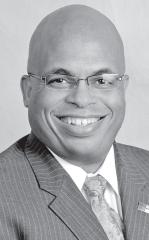
Rod Nunn, vice chancellor for economic development and workforce solutions, and Chris Stephens, professor in communications at STLCC-Florissant Valley, discussed a unique study-abroad program to Italy whose goal is to develop globally-competent workers who will positively impact the St. Louis economy. Nunn described how faculty and staff first spent countless hours meeting with more than 1,200 companies to determine their employment needs and the markets in which they operated. What they found was that even in a recession economy, with a surplus of jobseeking degree holders, employers still had trouble finding talented workers who possessed even basic professional skills. Nunn said that by polling employers and developing specific competencies that workers should possess, STLCC created an exchange program in Italy that provided students with experiential learning sought by businesses.
Stephens noted that experiential learning was the most effective way to impart the desired knowledge and skills, adding that language and cultural barriers made the students uncomfortable and forced them to learn faster than they would have in a familiar setting.
STLCC also assessed the students’attainment of the global competencies, and used the data to validate the program’s benefits to the students as well as the local economy.
Community colleges often face more challenges than fouryear colleges and universities when trying to expand international offerings. Funding may be difficult to obtain, and business leaders and trustees are likely to make the institutions focus on meeting the immediate community needs, namely developing a professional workforce.
In 1994, during the Rwandan genocide, Olive Mukabalisa was a 5-year-old living in a refugee camp in her own country. She lost her father, mother and a brother to the genocide.
In May, Mukabalisa was 8,000 miles away from the horror of her childhood, a remarkable Webster University student leader who joined the 1,000-plus graduates that took part in Webster University’s 94th Commencement ceremony at The MUNYin Forest Park.
Mukabalisa received a master’s degree in international relations. She was named the Alumni Association Outstanding Graduate Student in honor of her outstanding leadership and in recognition of her distinguished contributions to Webster. She also was honored last month by HateBrakers, a St. Louis nonprofit organization dedicated to combating various forms of discrimination, racism and human rights violations, for her work toward increasing understanding of the Rwandan conflict.
“Olive has been a strong leader on our campus since she was an undergraduate here,” said Bethany Keller, assistant director of Webster’s Multicultural Center and International Student Affairs.
“She came to Webster from Rwanda and has overcome significant personal obstacles to pursue her higher education. She is a passionate advocate for international students on our campus as well as for her home country of Rwanda. She is a true ambassador for the values of our institution.”
At Webster, Mukabalisa’s contributions include:
ï University Center Board Member
ï Treasurer for international Students Association
ï Graduate Senate Representative on the Student Government Association
ï Student Intern, International Institute of St. Louis, helping new immigrants to

“She is a passionate advocate for international students on our campus as well as for her home country of Rwanda.”
– Bethany Keller,Webster University
adjust to life in the U.S.
ï Student Intern, Jewish Holocaust Museum, doing research on the Rwandan Genocide and reviewing the country’s history and present-day situation in recovering from the past
ï Member, Webster University Working Group on Diversity Issues
ï Member, Human Dignity Club.
Mukabalisa plans to work in St. Louis for the next year, and then perhaps attend law school.
“Olive has an incredible passion for
Olive Mukabalisa,who just received a master’s degree in international relations at Webster University,was named the Alumni Association Outstanding Graduate Student.
human rights and social justice, and she invests her time, energy and talents in bringing attention to issues around the work and in searching for solutions,” said Katie Knetzer, assistant director of Housing and Residential Life at Webster.
“I recently spoke to Olive about her plans for the future, and she said that she hopes to someday work at the United Nations. Olive is the epitome of a global citizen.”
Webster University’s graduate degreeseeking student population represents the largest number of individuals of diverse backgrounds among all traditional, nonprofit U.S. higher education institutions, according to a 2011 survey published in “Diverse: Issues in Higher Education.”
The “Top 100 Degree Producers” survey for 2011 is the only national report of graduate degrees earned by African American, Hispanic, Asian American and American Indian students by U.S. colleges and universities.

American staff
Dr. Maya Rockeymoore, president and CEO of Global Policy Solutions, was elected to chair the Board of Directors of the National Committee to Preserve Social Security and Medicare for a three-year term.
Rockeymoore will work with the organization’s leadership to expand outreach and education initiatives to women and to communities of color.
As the first African American woman elected to chair the National Committee’s board of
directors, Dr. Rockeymoore will work with the organization’s leadership to expand outreach and education initiatives to women and to communities of color, the fastest growing segment of the U.S. population and among the most economically vulnerable.
“The National Committee has accomplished so much in its 30year history and I look forward to helping build upon the legacy of U.S. Representative James
Roosevelt to ensure that these programs are available for our children and grandchildren,” said Dr. Rockeymoore.
“People of color rely heavily on Social Security and Medicare. Together, we will help our communities become forceful advocates, ensuring that our leaders understand how communities of color use these programs and how they can be modernized to meet the needs of our increasingly diverse
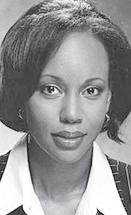
Dr.Maya Rockeymoore
society.”
Dr. Rockeymoore has been a member of the National Committee’s board since 2005 and brings valued leadership as an income security expert working with African-American, Latino and Asian American communities. She was vice president of research and programs at the Congressional Black Caucus Foundation, senior resident scholar for health and income security at the National Urban League, and served as chief of staff to U.S.
Representative Charles Rangel. Dr. Rockeymoore is co-editor of Strengthening Community: Social Insurance in a Diverse America
“Our nation’s most successful poverty prevention programs continue to be in the cross-hairs of too many in Washington who believe we should cut middle-class benefits to pay for flawed fiscal policies which protect the wealthiest among us,” said Max Richtman, president and CEO of the National Committee to Preserve Social Security and Medicare.
“Dr. Rockeymoore has a long and successful career
advocating for social change that strengthens rather than divides our nation. We are fortunate to have her leadership as board chair at this critical juncture in the history of Social Security, Medicare and Medicaid.”
The National Committee, a nonprofit, nonpartisan organization acts in the interests of its membership through advocacy, education, services, grassroots efforts and the leadership of the Board of Directors and professional staff. The work of the National Committee is directed toward developing better-informed citizens and voters.
By Vicki Wroblewski For The St.Louis American
The mission of St. Luke’s Hospital is to improve the quality of life for our patients and the community. We live this mission by offering a broad range of services and quality patient care through the efforts of exceptional people, all while keeping a strong focus on our commitment to the broader community. Celebrating diversity — among our patients, staff/leadership and beyond — is important in helping us achieve our mission. Reflecting the richly diverse community we serve in our hospital community makes a positive impact on the overall well-being of our patients
and the community as a whole. Specifically, persons who are African-American are key members of our hospital team, including those who work directly with patients as well as those in leadership positions within the hospital and on our board of directors. Managers have the opportunity to participate in training related to diversity, and soon all employees will be able to benefit from a similar program. In an effort to help cultivate diverse healthcare professionals and leaders of the future, St. Luke’s has participated in SLIP, the St. Louis Internship Program, since 1996. SLIP’s mission includes providing inspiration, support, professional development and train-
ing to underserved high school students, most of whom are minority students, so they can obtain valuable internships in professional settings. As a proud corporate partner, St. Luke’s helps the students realize their potential by exposing them to healthcare job opportunities and providing them with meaningful work during eightweek summer internships. St. Luke’s also celebrates diversity in terms of gender. Women are included in leadership roles within the hospital and on our board. In terms of

community outreach, we celebrate the health of both men and women, but because women typically take care of everyone else in their lives first and themselves last, St. Luke’s encourages women to take action for their health and the health of their families through a program called Spirit of Women. St. Luke’s is the only Spirit of Women hospital in St. Louis, which means we are committed to providing exceptional women’s services, education and community outreach programs. There are many other ways

Persons who are African-American are key members of our hospital team, including those who work directly with patients as well as those in leadership positions.
St. Luke’s celebrates diversity. We respect the contributions of those with diverse developmental abilities. Through the Productive Living Board, we support the hiring and retention of individuals with developmental disabilities.
As a faith-based organization, we provide pastoral care
for all faiths. Additionally, patients of all income levels are served by St. Luke’s. As a not-for-profit hospital, we provide care regardless of a patient’s ability to pay according to our financial assistance policy. And St. Luke’s Pediatric Care Center in North St. Louis County provides ongoing primary medical care for underserved children. These are just a few of the many ways St. Luke’s celebrates diversity in order to make a positive difference in the lives of our patients and the community we serve.
Vicki Wroblewski is St. Luke’s Hospital Assistant Director of Human Resources.

By American staff
Retired Judge Booker T. Shaw is a partner in the Business Litigation Practice Group at Thompson Coburn, where he brings clients valuable insight and perspective gained from his more than 25 years on the bench. His knowledge of current judicial thinking at the trial and appellate levels on a wide range of issues enhances the Business Litigation Group’s ability to argue a client’s case more persuasively and to craft the most effective strategy.
Judge Shaw has launched his Alternative Dispute Resolution practice with
Thompson Coburn, and he is part of the St. Louis community. He grew up in the Ville neighborhood and attended St. Louis Public Schools: Simmons Grade School, Turner Middle and Sumner High School.
He continues to help young minorities aspire to be successful. He mentors those of all ages from grade school children, college, law students and young lawyers. He is making a difference by being a resource, mentor and role model.
Judge Shaw’s unique judicial background also brings tremendous value to Alternative Dispute Resolution proceedings. As a certified
mediator, Judge Shaw’s decades of experience allow him to critically analyze the strengths and weaknesses of a broad range of claims, look critically at all facts and defenses, and lead parties to a successful resolution.

At the trial court level, Judge Shaw’s patient and thoughtful approach enabled him to facilitate the settlement of many difficult and complex cases. Now his talents for problem solving and conflict resolution offer
parties the opportunity to reach mutually beneficial solutions.
Judge Shaw received Mediator Certification at the highly regarded Center for Dispute Resolution at the University of Missouri. He is an approved mediator for the U.S. District Court for the Eastern District of Missouri, the Circuit Court of the City of St. Louis and the Circuit Court of St. Louis County.
Judge Shaw served on the Missouri Court of Appeals, Eastern District for seven
years, including one year as chief judge. While on the appellate bench, he participated in more than 1,000 cases and authored 141 appellate opinions on a variety of cases, from medical negligence and nuisance/sovereign immunity to commercial transactions, contracts, and personal injury. He also served as a Special Visiting Judge of the Missouri Supreme Court.
As a former trial judge in the 22nd Judicial Circuit, from 1983 until 2002, Judge Shaw presided over more than 500 trials.
Prior to his judicial posts, Judge Shaw worked at the U.S. Department of Justice, the
American staff
Jamba Juice Chairman, President and CEO James White, a Fontbonne University alumnus, has always been driven to succeed. While attending Northwest High School in St. Louis, he participated in Inroads, a pre-college program for African-American students where he got his first look into the business world. From there, he was hooked.
“That program was really beneficial for me. It helped me identify my passion for business,” White said.
This passion inspired him to earn a bachelor’s degree in marketing and to then go on to
work at companies such as Coca-Cola’s Minute Maid Orange Juice Division, Ralston Purina and The Gillette Company.
And then, when White realized he wanted to round out his business education, he enrolled in Fontbonne’s MBA program.
“I wanted to continue to move and learn in my career,” White said. “Enrolling at Fontbonne served as the catalyst for renewing my overall passion about continuous learning.”
When Jamba Juice came calling in December of 2008, shortly after the economy started its steady and drastic
decline, Jamba needed big leadership that could not only oversee its turnaround, but also transform the company. White pulled from his vast business experience and his education to take on the sizeable task ahead of him.

“I was inspired by the opportunity to lead the transformation of both our company and the industry,” he said.
“I knew that Jamba Juice represented an iconic brand with legendary service culture
and an aura of West Coast cool. I was confident that with these ingredients –and the right vision, leadership and disciplined management – we could achieve great success. Many of the leadership practices I adhere to today were honed during my time at Fontbonne.”
With White’s knowledge and expert leadership, the company has begun to flourish once again. In fact, Jamba Juice is quickly expanding, and White is currently working
with a group of partners, spearheaded by former Anheuser-Busch president Dave Peacock, to bring Jamba Juice to St. Louis. They plan to debut multiple locations in the area in August 2013.
“We’re excited to be entering the St. Louis market,” White said. “I think we can bring great tasting, healthy food and beverage solutions to the area and do so in a fun, service-oriented environment. We are also excited to serve as a positive influence in St. Louis community as a whole.”
Fontbonne University is a Catholic coeducational institution of higher education offer-
Federal Trade Commission and the St. Louis Circuit Attorney’s Office, where he tried more than 50 criminal cases to verdict before a jury, securing guilty verdicts in all but two trials. In addition to his decades of public service as a distinguished jurist, Judge Shaw continues to give back to the legal profession. He has taught trial advocacy at Washington University School of Law since 1995 and served as an instructor at the National Institute of Trial Advocacy since 1999. He also frequently speaks at Missouri Bar continuing legal education programs.
“Enrolling at Fontbonne served as the catalyst for renewing my overall passion about continuous learning.”
– James White
ing liberal arts and professional programs, as well as evening and online formats for busy adults. Fontbonne was founded in 1923 and is sponsored by the Sisters of St. Joseph of Carondelet.


Continued from page 6
Mays recalled a story from an All-Star game in the 1950’s.
Before the game, in one corner of the National League clubhouse, sat Mays, Hank Aaron, Ernie Banks and Frank Robinson, playing cards all by themselves.
The white ballplayers on the national league roster either ignored them or were openly hostile. So Stan Musial, who by then was one of the biggest stars in the game, simply walked over, sat down and said, “Deal me in.”
That was his way of saying, fellas, you belong here. It’s gonna get better, and I’m glad to have you on my team.
When asked about his friend’s passing, the great Hank Aaron – baseball’s legitimate all-time home run king, and someone who faced much hateful racism himself – said this of Stan: “I not only liked Stan Musial, I wanted to be like Stan Musial.”
Two years ago, I was privileged to accompany Stan and his family to the White House as President Obama awarded him the Presidential Medal of Freedom. The President said this of Stan:
“His brilliance could come in blinding bursts: hitting five home runs in a single doubleheader; leading the league in singles, doubles, triples and RBI’s over a single season. Stan Musial made that brilliance burn for two decades, even as he missed a season in his prime to serve his country in the US Navy during World War II.Stan remains, to this day, an icon, untarnished; a beloved pillar of the community; a gentleman you’d want your kids to emulate.”
That is absolutely true.
And soon, when millions of Americans cross the beautiful new bridge that will bear his name, I hope they will remember that Stan Musial was more than just a proud veteran and a great ballplayer.
Special to The American
Stacey Stewart, assistant vice president, Bank Secrecy Act (BSA) officer at Heartland Bank, began her career in banking over 21 years ago, like many, by accident.
While attending college full-time, her girlfriend suggested they attend a local job fair. On a whim, she submitted her application for a part-time personal banker position at Normandy Bank and was offered the job on the spot.
Her part-time job soon turned into full-time positions as a loan secretary and as a representative in the loan
administration department. When Normandy Bank merged with another financial institution to form Keystone Bank, she moved into the accounting department. And when Keystone Bank was purchased by Truman Bank, Stacey became the operations supervisor, and ultimately the assistant vice president of operations, before joining Heartland Bank.

Stacey Stewart
When asked what has been the key to her success, she explains that it’s been her ability to adapt and learn new
skills, all while maintaining a positive attitude.
“Banking is ever-changing, and buyouts and mergers are unfortunately very common,” Stewart said. “The idea of working for the same institution your entire career just doesn’t happen much any more. So you have to be ready and willing to embrace new challenges.”
When asked what she’s enjoyed most about working in banking, she says, “It’s the people, both clients and co-workers. At the end of the day, it’s the people you
work with day-in and day-out that make getting up in the morning to come to work so gratifying. Banking is very personal. People entrust you with their livelihoods and I truly value the strong relationships I’ve built over the years.”
When Stewart is away from Heartland, she enjoys reading, spending time with her son, a 2013 graduate of McCluer North High School, and watching sports.
“I’m a big NBAfan,” she said. “And I probably shouldn’t admit it, but the Miami Heat are my team!”
By Benjamin Akande For The St.Louis American
This is a story about the importance of empowering others.
John T. Quinlivan, a retired executive at Boeing Corporation, shared this wonderful story with me. It’s a story about a simple act we all take for granted.
Afew years back John was the person in charge of delivering Boeing commercial jets to countries around the world. This particular delivery was to the nation of Kenya. The Boeing 767-400 plane landed at the Kenyatta International Airport with much fanfare and celebration.
The day began with great pomp and ceremony, as Boeing entertained airline executives and top government dignitaries with a demonstration flight in the new 767 over the beautiful landscape of Kenya. Later that day, the aerospace giant opened the airplane up for what is generally referred as static display, where people are invited to walk through the plane, sit on the seats and get an up-close look of the
plane.
More than two thousand Kenya Airways employees and invited VIPs showed up to get a glimpse of the country’s new acquisition that afternoon. At the completion of the static display, the plane was cleaned and secured for the night.

But then, the unaccepted happened. Agroup of children from a nearby orphanage showed up. They came to see the big bird that had landed near their home close to the airport.
Despite protestation from the hosts, John Quinlivan insisted that they too should get a tour of the brand-new plane. When they finally made it on the tarmac, they stood transfixed at the bottom of the stairway looking up at the massive bird.
From the top, John motioned to them to come up, but nobody responded to him.
“They just stood there,” John told me, and then he asked one of the Kenyan hosts to tell the children and

adults who were with them in Swahili to walk up the stairs.
Again, there was no reaction.
It became clear to John that he had a small problem. The problem? The children and their handlers had never walked up stairs before. They didn’t know how.
With the help of the Boeing staff and Kenyan hosts, they assisted the children as they made their way up to the plane. It took a while, but they finally made it to the top of the stairway and into the plane. They stretched out on the large seats in first class, checked out the cockpit, sat in the pilot’s seat and looked in the restrooms.
At the end of the tour, it was a sight to see the kids attempting to walk down the stairway. Afew, who found it more comforting and assuring to just sit on the steps, slid their way down as carefully as they could.
This is a story about a simple act
that we take for granted. My friends, walking up stairs is enabling others to reach their goals. Walking up stairs is overcoming insurmountable odds and doing the impossible. When we walk up stairs, we are enabling others to participate in the American Dream. It begs the question: what stairs are you helping others to climb?
According to John, “The people of Kenya were thrilled to be a part of the Boeing 767-400 tour. But it was more than that. They were so proud of their new plane. You see, we must always remember the radical changes that products/services bring to people’s lives and the transformational capacity to an organization or even to a nation and to its people.”
For John, it’s about access, opportunity, inclusion and education. These are defining attributes that are to be part of DNAof any organization. Which begs the question: are you enabling these attributes in your organization?
Benjamin Akande is dean of the Walker School of Business at Webster University.

wanted to take. I worked them up like they were million dollar cases.”
Continued from 1
start law school at Saint Louis University. And a year before, she also got married.
She graduated SLU Law in 2009 and went to work with the Land of Lincoln Legal Assistance Foundation, which is an Illinois non-profit group that provides free civil legal services to low-income persons and senior citizens in central and southern Illinois. Brock worked on many cases in East St. Louis, especially domestic violence and housing disputes. Often the housing cases revolved around landlords who were providing substandard conditions. In some instances, she thought, “I would not have allowed my dog to live in this house.”
Growing up, Brock remembers asking her friends who lived in rundown rental units why they didn’t tell the landlord to repair the building. She didn’t realize then that sometimes landlords refused to fix things, and the families felt powerless to fight back, she said.
“Many landlords were treating the citizens like they should be lucky to have a roof over head,” she said. “I started to fight harder. I would take cases to trial that no one else
Continued from 1
ferred 474 associate degrees to African-American students, accounting for 22 percent of the total number of degrees conferred during that academic year. The figure also represents a 19 percent increase over the number conferred to AfricanAmerican graduates in 201011. According to the article, the number of associate degrees awarded to minority students nationally increased by 15 percent between aca-
It felt good to give her hometown a voice, she said, and be an agent of change in their lives. Although she now lives in St. Louis’Central West End, she said East St. Louis is still home.
Brock loved her work at the foundation, but her student loan bills were knocking at the door, she said, making it impossible to stay. So in 2012, she joined Brown & James law firm, where she works on insurance defense cases and participates in the firm’s many training opportunities.
“Brown & James cares about the whole person and not just the attorney in you,” she said.
However, Brock still makes time to take on pro-bono cases with Land of Lincoln. This June, Brock volunteered to represent a woman whose exhusband had taken her minor daughter from Illinois to Tennessee.
“Half the battle was getting her to feel comfortable confronting her military-made exhusband,” she said, a situation she had commonly seen growing up in East St. Louis.
Her pro bono legal work is not the only way Brock gives back to her community. Brock serves as the president of Great Things Incorporated, which
The 474 associate degrees awarded to African-Americans by St.Louis Community College in 2011-12 represents a 19 percent increase over the number conferred in 2010-11.
demic years 2010-11 and 2011-12.
“Over the past three years as an Achieving the Dream school, St. Louis Community College has looked at perform-
provides dinner programs (hot meals served restaurant-style) to the homeless, GED programs and tutoring.
Since 2010, Brock has also been helping Associate Circuit Judge Laninya Cason of St. Clair County with facilitating the “Diamonds in the Rough” program that mentors at-risk East St. Louis teen girls (13-14 years old). The topic of becoming a teen mom comes up occasionally, she said, and she talks to the girls about her experience.
“I explain that I had to delay the things I wanted to do,” she said. “I tell them that having a baby is not like having a doll. This is your responsibility.”
Brock feels that the major obstacles are behind her now, and she’s proud that she achieved her goals. Her daughters are on the way to doing the same. Her oldest daughter is a nursing student at Southeast Missouri State University. The other girl ranks in the top 10 students in her high school class and wants to be a journalist.
“There are some bad assumptions out there about people from East St. Louis,” she said. “Now I don’t have to say, ‘Oh, there’s that person from East St. Louis who made it.’I can say, ‘I am that person from East St. Louis that made it.’”
ance gaps for our most significantly underserved population – our African-American students,” said Donna Dare, Ph.D., vice chancellor for academic and student affairs.
“The college has engaged in an African-American Male Initiative, Commit to Complete, Gateway to College, Upward Bound, TRIO and other programs and services to make every effort to mitigate those gaps. We continue to examine the effectiveness of all our strategies to reduce disparities in student success.”
For more information about STLCC, visit www.stlcc.edu.
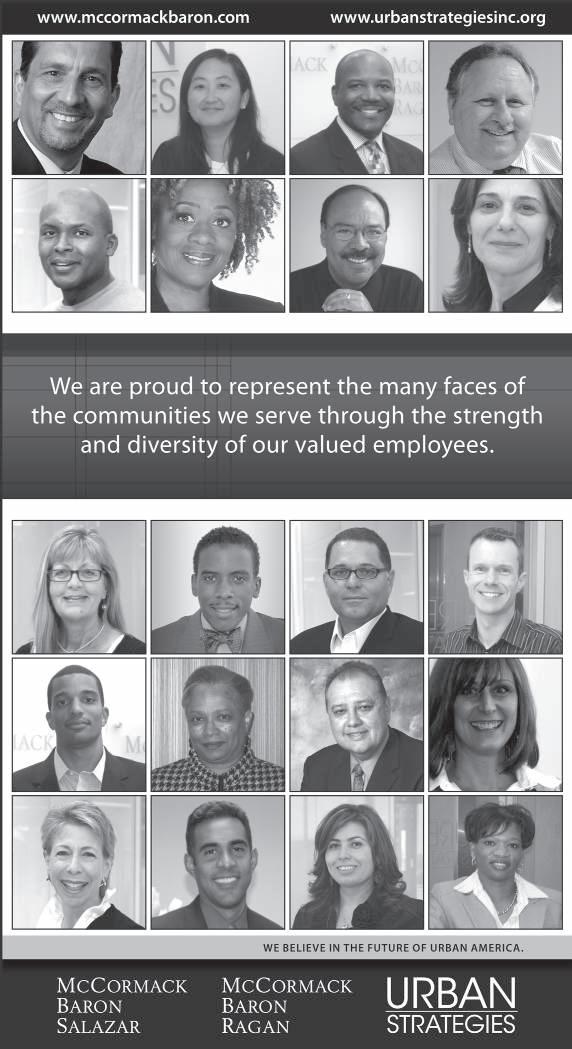
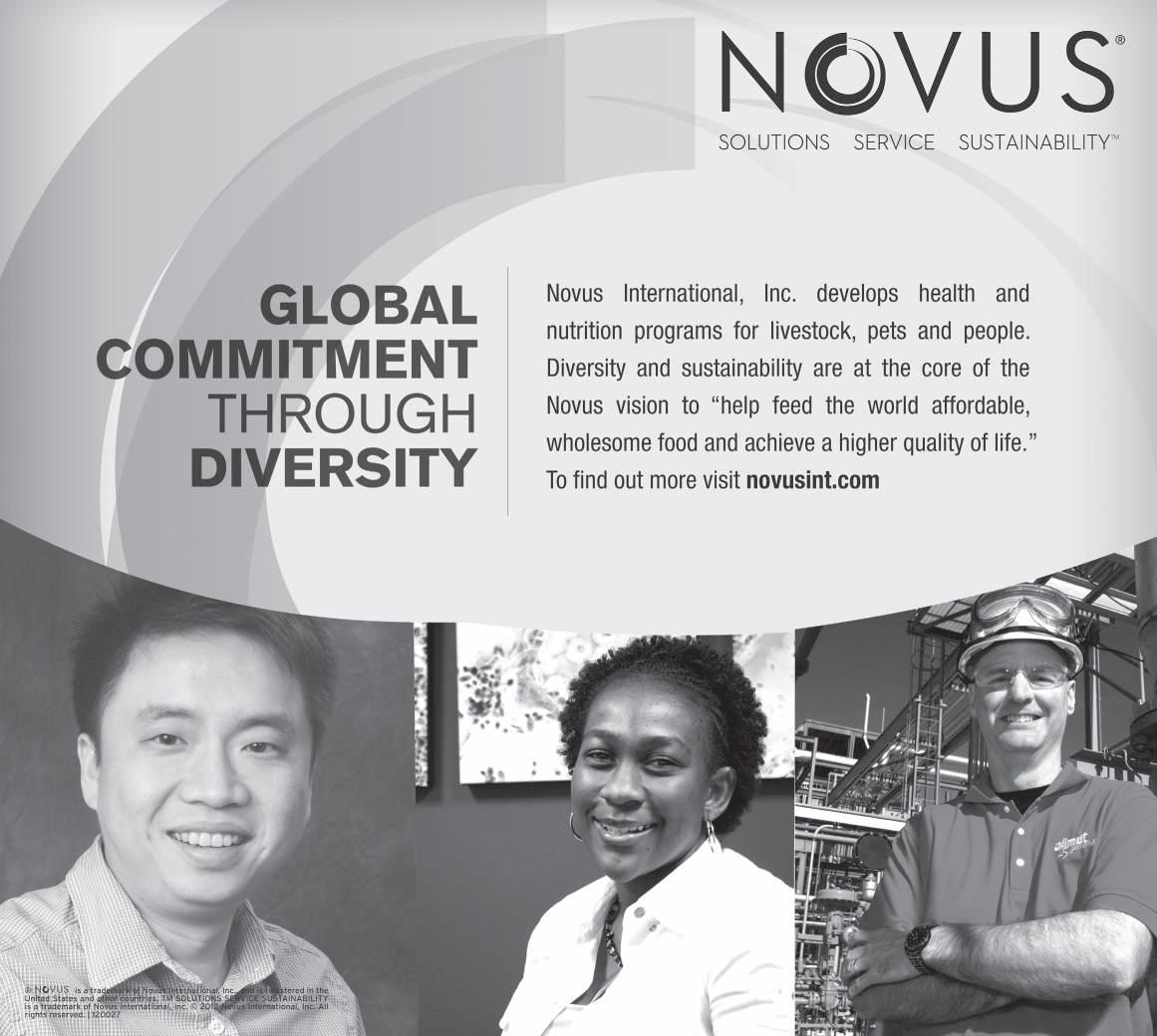
By American staff
Q: Describe yourrole within the firm.
A: I am a Department Leader for IS Quality Change in the Quality Methodology area.
Q: Describe how yourdivision contributes to the firm’s success.
A: The IS Quality Change department provides coordination and distribution services of production system changes to minimize outages to business processing, branch offices and users.
Q: What yeardid you start at Edward Jones? What year did you start in yourcurrent position?
A: I came to the firm in June 1995 and took this position in June of 2008.
Q: What did you do priorto joining Edward Jones?
A: I was a student at Florida A&M in Tallahassee, FL.
Q: Before you came to Edward Jones, what did the name mean to you? And afteryou came on board?
A: I didn’t know much about Edward Jones in college. They were well known among busi-
ness majors but not with computer science students. After coming to Edward Jones and understanding how they compared to other financial institutions, I quickly understood that this was a company on the verge of being an outstanding company. That the technology changes that they were gearing up to implement would change how Edward Jones did business and could help increase the number of potential customers.
Q: One area Edward Jones prides itself is enabling our associates to maintain a strong work-life balance. How does this approach impact you?
A: I moved here right after college with no family close by that I could visit. So all I had was work. But Edward Jones is involved in a number of community programs and I happened to take a special liking to the Girls Inc. Summer Computer program. This helped me to meet other people and give back to the community as well. After being here 11 years and starting a family of my own, I’ve been able to use remote access to maintain a good work-life balance. This allows me to go home and spend time with my family and catch up with work without having to physically be away from my family.
Q: What does the firm being
Niki Bailey is Department Leader – Quality Change Services for Edward Jones. She is also the Edward Jones coordinator for the Girls Inc.Computer Summer program and a volunteer teacher for the program.
a partnership mean to you?
A: Being a limited partner in the firm means I share in the responsibility of the firm. That means in my dayto-day activities I have to think like an owner. The firm’s number one focus is the customer, and as a partner in the firm I have to make sure that everything I do contributes to helping our clients reach their financial goals.
“Everything I do contributes to helping our clients reach their financial goals.”
– Niki Bailey
Q: Articulate the spirit of volunteerism that exists at Jones. How have you been involved and what was that experience like?
A:I am the Edward Jones coordinator for the Girls Inc. Computer Summer program as

well as a volunteer teacher for the program. This program is special because the associates that get involved get a chance to show off their talents as well as learn. We went from just teaching computer concepts to teaching life skills and encompassing all areas of Edward Jones into the program. Students learn how to type, balance a checkbook, build a business, create a marketing plan and develop a database. Each year the number of girls that participate in our program grows because of the increasing number of volunteers. Every new volunteer is terrified of teaching, but the kids in this program teach them how to let themselves go. At the end, we have made new friends and can’t wait for next summer to begin.
Q: Do you feel there are opportunities foradvancement and greaterincome potential at Edward Jones?
A: Yes. I started as a programmer in the BSD area and was asked to consider spending a year in internal audit. This opportunity gave me exposure to the business area and a different perspective. This was beneficial for me as I returned to IS to take a position as a project leader. I was promoted to team leader shortly thereafter.
Q: What qualities do you think a person needs to have to succeed in the home office environment?
A: Aperson working at the home office has to handle change well and should be willing to put the customer first in every thing they do. Taking responsibility and ownership of an issue through to resolution is a must for a home office associate. And it’s important to understand that at the end of the day we are a part of a team that is dedicated to helping the customer.
Q: As you go through your daily activities, how do you know you’ve achieved success at Edward Jones?
Q: There are very few offices at Edward Jones, with nearly all the firm’s leaders located in cubicles. What does this structure mean to you?
A: Cubicles give you privacy when you need it but it also fosters an open door policy. I know that I can walk up and see someone and I don’t have to make an appointment. The door just seems so formal.
Q: How has the firm supported yourprofessional growth via training opportunities?
A: I have been able to take classes on new technology that my area will support, but the most helpful training has come from other associates here at Edward Jones.
Q: How do you see your future at Edward Jones unfolding?
A: The opportunities here at Jones are endless and the potential to learn new things are always available.
A: I feel success in many ways. I feel it when I get a thank-you from a leader of a team whose problem I helped resolve. Or when a Financial Advisor sends in a wire to say thank you or when there’s a crisis and other associates thank me for sticking around to help them even when it’s not my responsibility. Then you know you had a good day.


Elena Kenyon, Mama Lisa Gage and Silvia Martinez
American staff
Gitana Production’s 2013 Extraordinary Person of the Year: Deeds Beyond Race, Religion and Nationality is Elena Kenyon, and the runners-up were Mama Lisa Gage and Silvia Martinez.
“This award recognizes the extraordinary efforts of ordinary people who bridge racial, cultural and religious divides in their day-to-day lives,” said Cecilia Nadal, executive director, Gitana Productions.
“We honor people who make a difference and yet may not be known to most of us within the St. Louis region.”
Originally from Galicia, Spain, Elena Kenyon, was a Spanish teacher in the Lindbergh School District for 35 years. She noticed that many of the African-American kids who were bused to Lindbergh were not as engaged socially, so she voluntarily spear-headed an after-school program including a talent show and started a mentoring program to build self-esteem and pride among the youth and their parents. The program was very successful and continues today.
This spirit of service is reflected in many aspects of Elena’s life with the community of people who are poor, the homeless and with Latino families associated with the service program from Our Lady of Guadalupe Church’s St. Vincent DePaul Society.
“For Elena, service has been a way of life in Spain as well as the United States,” Nadal said. “Her years of commitment across cultures and as a volunteer was indeed impressive.” Silvia Martinez was a run-

Mama Lisa Gage,Silvia Martinez and Cecilia Nadal, executive director for Gitana Production’s
Gitana Production’s 2013 Extraordinary Person of the Year is Elena Kenyon.
ner up for this award. She serves as an Intake Coordinator at the Catholic Charities Community Services Southside Center. Silvia over the years has reached out beyond the call of duty to identify community resources to support the varied needs of the Latino community, whether it is finding financial support for healthcare, legal counsel, distributing food donations for the most in need or just being a friendly listening ear for many Latinos.
“Her ability to make everyone feel welcome with a sense of safety was noted as her out-
standing quality,” Nadal said.
Mama Lisa Gage, also a runner up, was nominated for her role as a “world ambassador” as educator, dancer, storyteller and choreographer. She has worked on programs regarding Caribbean Carnival traditions and worked with Grupo Atlantico, a Columbian dance ensemble to amplify the artistic connections between Africa and South America.
Her work has been featured at the Missouri History Museum, the African Arts Festival and local libraries and universities.
“Gitana is committed to demonstrating, within arts and education, the vital connection between global healing and local humanitarianism,” Nadal said.
Visit www.gitana-inc.org to see other winners of this award




Area citizens were recognized for outstanding community leadership and volunteer support at the Call for Help Annual Celebration & Pillar of Hope Awards on June 15 at St. Clair Country Club. Richard Mark, chairman, CEO and president of Ameren Illinois, received the Outstanding Community Leader award. The Peters family of Belleville and six fraternities and sororities were honored for volunteer support.
Pictured with their awards are, front row, from left, Call for Help Board President Melinda Nicholson, honorees Caroljean Peters; Denise
Merritt, Sigma Gamma Rho; Denise Hilliard, National Council of Negro Women; Nakia Daniels, Alpha Kappa Alpha; Richard Mark, Ameren Illinois. Second row, honorees Doug Peters; Arthur Peters; Carmella Hardnett, Delta Sigma Theta; Jason Ford, Omega Psi Phi; James Daniels,

Kappa Alpha Psi; Call for Help Executive Director Cheryl Compton. Amember of the United Way of Greater St. Louis, Call for Help delivers support and relief to enable people to overcome such personal crises as homelessness, mental illness, personal distress and sexual assault. Programs include Suicide and Crisis Services, Sexual Assault Victims Care, Transitional Living Center for homeless young women, Community Stabilization residential program for homeless mentally ill, and Information & Referral. Call for Help is
a

By Rebecca S.Rivas Of The St.Louis American
In May, Otis Scott became Walmart’s regional human resources director for the entire state of Missouri, including East St. Louis and Kansas City, Kansas, but excluding Branson and Joplin.
In his new position, he oversees 30,000 hourly workers and 5,000 managers in more than 130 stores. He spends a lot more time working on strategy.
ect, I’m always thinking, ‘How can I infuse inclusion into our strategy?’That’s my job.”
“In my role, I do anything I can to help leverage diversity and to keep it in the forefront of our minds – because I understand that it’s a thread in our culture.”
– Otis Scott
“Not a day goes by that I don’t think about diversity and inclusion in any strategy, from promotions to retention,” said Scott, who was previously Walmart regional manager of human resources. “In any proj-
Walmart just opened new “neighborhood markets” in Kansas City, he said. When Walmart enters into a community in his area, he makes sure that it has a diverse workforce.
“Diversity and inclusion are a huge part of the Walmart’s culture,” Scott said. “One of the things that I love about Walmart is that we really pride ourselves on making sure that we are part of the community, not just a store in the community.”
Scott said Walmart takes its responsibility in the communi-

See SCOTT, page 35 Otis Scott is Walmart’s
and Kansas City,Kansas,but excluding

By Rebecca S.Rivas Of The St.Louis American
Despite the myth, African Americans are actually helped – not hurt – economically by Latino immigration, according to a recent study released in June by a Saint Louis University professor.
“To the extent that there really is a ‘black-brown’ divide, it is rooted in politics and perception – not economics,” writes Jack Strauss, author of the study “Allies, Not Enemies: How Latino immigration boosts African American employment and wages.”
Immigration from Latin America improves wages and job opportunities for African Americans, according to Strauss’analysis of U.S. Census data from 907 U.S. metropolitan areas in 2010 and 455 metros in 2005. The study is the largest economic examination of immigration’s effect
on African Americans in terms of wages and employment to date. Strauss is the Simon Chair of Economics at Saint Louis University and director of the Simon Center for Regional Forecasting. African Americans in metropolitan areas with more Latino immigration experience significantly higher wages, lower unemployment and higher job creation, the report found.
For every 1 percent increase in a city’s share of Latinos, African-American median and mean wages increase by 3 percent. This number is large, Strauss said. St. Louis has only 1.5 percent of its population from Latin America. If St. Louis had a Latino population as large as other large metropolitan areas, African-American wages would be approximately 30 percent higher, according to the report.
“It is often assumed that
Latino immigrants and African Americans are locked in ruinous competition for the same jobs, resulting in lower wages and higher unemployment rates for African Americans,” Strauss writes.
“In fact, Latino immigrants and African Americans fill complementary roles in the labor market – they are not simply substitutes for one another. In addition, cities which have suffered the effects of declining population are rejuvenated by an inflow of Latino immigrants who increase the labor force, tax base, consumer base, etc.”
“To the extent that there really is a ‘black-brown’ divide, it is rooted in politics and perception – not economics.”
– Jack Strauss, Saint Louis University
Americans in poverty and more with higher incomes. For every 1 percent increase in a city’s share of Latinos, the city experiences a 1.6 percent increase in relatively welloff African Americans and fall in poor African Americans. Also in every age group, Latino immigration lowers AfricanAmerican unemployment.
Currently many metro areas in the Midwest, including Cleveland, Dayton, Detroit and St. Louis, are not experiencing vibrant population growth.
The study found that cities experiencing Latino immigration have fewer African
American staff
Nicole Colbert-Botchway sworn in as the 91st president of the Mound City Bar Associationat the 2013 Scovel Richardson Scholarship Dinner on Saturday, June 29.
Mound City Bar is one of the oldest black bar associations west of the Mississippi River.It was organized as the St. Louis Negro Bar Association on January 13,
“Instead, aging baby boomers and negative net migration are leading to a hallowing out of cities, declining school revenue, falling housing
prices, big businesses moving their headquarters, and a dearth of small businesses,” the study states.
St. Louis has experienced a sharply declining population, and at the same time, very little Latino immigration, he said. As a result, St. Louis has closed more than a dozen schools in recent years, which has cost the jobs of hundreds of AfricanAmerican teachers, administrators and staff.
Strauss’research shows that an increase in immigration from Latin America would have sustained St. Louis’population, tax base, school enrollment, and most of the lost African-American jobs. It would have also reduced crime among young African-American men by giving them more economic opportunities.
“The impact of Latino immigration on the AfricanAmerican labor market is a
1922, shortly after World War I. At that time, black lawyers were not allowed to join the all-white St. Louis Bar Association.
Alifelong resident of the city of St. Louis, Nicole Colbert-Botchway earned her Bachelor’s and Juris Doctorate Degrees from St. Louis University in 1993 and 1996, respectively.
Before joining the Missouri Attorney General’s Office in
2004 as Child Support Unit Leader for the Financial Services Division, she served six years as a prosecutor in the St. Louis Circuit Attorney’s Office and earned an MBA from the University of Missouri-St. Louis. This year she was elected to the Board
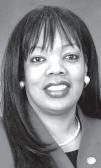

of Governors of the Missouri Bar - a statewide organization that serves all 29,000 of Missouri’s practicing attorneys. She also serves on its Professionalism Task Force, the Missouri Supreme Court’s Child Support Guidelines Review Subcommittee and its Joint Committee on
Gender and Justice. She is the first AfricanAmerican president of the Women Lawyers’Association of Greater St. Louis and its first lifetime member.
Mound City Bar’s objectives are to advance the professional interest of its members; to improve the administration of justice; to uphold the honor of the legal profession; to promote the professional development of our members; and to
critical but scarcely addressed topic in the economic literature,” Strauss said.
Strauss explains that there is a prevailing view that immigrants, including Latinos, are willing to work for less, and therefore have taken jobs away from African Americans. As a result, policy institutes, political science and sociology journals, as well as the popular press have widely reported on tensions between African Americans and Latinos.
Anumber of recent studies attribute these tensions to “economic competition among ethnic groups.”
Although a perceived “brown versus black” conflict may exist, it is not based on economics, Strauss states.
“Rather,” he said, “it stems from political competition for representation and, at times, misinformation.”
provide service to the community. It also provides a host of other professional and social networking opportunities for judges, attorneys and law students, including an annual picnic, holiday reception, cosponsoring programs with the Bar Association of Metropolitan St. Louis and The Missouri Bar, and providing pro bono services to the community.

Steven W. Hawkins hopes ‘to expose human rights abuses’
American staff
NAACPExecutive Vice President and Chief of Programs Steven W. Hawkins has been selected to take the helm of Amnesty International USAas its executive director. Hawkins has been a part of the senior leadership team that led the association through a five-year period of financial growth and political prominence.
“I am humbled and honored by the opportunity to lead Amnesty International USA, the organization that has not just led, but effectively defined, the global human rights agenda for more than 50 years,” said Hawkins.“I am looking forward to working with their excellent team to continue to expose human rights abuses and mobilize the American public.”
“Steve has one of the very best strategic minds in the civil and human rights communities.”
– NAACP President Benjamin Todd Jealous
release of three black teens who were wrongfully convicted in Tennessee. As executive director of the National Coalition to Abolish the Death Penalty, Hawkins developed several initiatives that addressed racial disparities in capital sentencing, including a campaign that ultimately led to eradication of the death penalty for juvenile crimes. From there he moved to the world of philanthropy, working for both the JEHTFoundation and Atlantic Philanthropies. Hawkins joined the NAACPin 2008 to serve as executive vice president under President and CEO Benjamin Todd Jealous.
Hawkins began his career as an attorney with the NAACPLegal Defense Fund, where for nearly six years he represented African-American men facing the death penalty throughout the deep South. During this period, Hawkins investigated and brought litigation that led to the successful
“Steve has one of the very best strategic minds in the civil and human rights communities, and he’s dedicated his professional life to advancing social justice,” said Jealous. “Amnesty International USA could not have selected a more perfect match for their storied organization, and I look forward to continuing to work closely with Steve and Amnesty in the years ahead.”
“Steve Hawkins has an innate understanding of grass-

roots advocacy and the power of people to affect social change,” said Shahram Hashemi, board chair of
Amnesty International USA. “He will be a galvanizing force in inspiring and engaging our members, volunteers, sup-
porters and staff. We are excited and honored to have Steve at the helm. He is a leader with the heart, compassion, vision
and drive to help us win the human rights battles ahead.” Hawkins begins his new post in September.

Fifteen minority students were among the 78 physicians in the 39th graduating class at Southern Illinois University (SIU) School of Medicine. The graduates received their diplomas during ceremonies on Saturday, May 18 in Springfield, Ill.
Dr. Britanne Socks Doss will begin a research assistant position at Southern Illinois University School of Medicine in Springfield in July. She is the daughter of Barry and Penelope Socks of Chantilly, Va., and is married to Clifford Doss from Springfield. She is a graduate of Chantilly High School in Chantilly, Va., and the University of Virginia in Charlottesville, where she earned her bachelor’s degree in psychology.
Dr. Raven J. Holland will enter a family medicine residency at Hinsdale Hospital in Hinsdale in July. She is the daughter of Lawrence Holland of Chicago and Rhonda Holland of Sauk Village. She is a graduate of Marian Catholic High School in Chicago Heights and Prairie View A&M University in Prairie View, Texas, where she earned her bachelor’s degree in biology.
Dr. Jeffrey B. Hubbard is the son of the late Bennie Lee and Evelyn Hubbard. He is a graduate of Jesse H. Jones Vanguard High School in Houston, Texas, and Florida A&M University in Tallahassee, where he earned his bachelor’s degree in biology and master’s in physiology.
Dr. Stacy A. Jefferson will
begin a master of public health program in epidemiology. She is the daughter of Andrew Jr. and Mary Jefferson of Normal. She is a graduate of Normal Community West High School and Spelman College in Atlanta, Ga., where she earned her bachelor’s degree in chemistry.
Dr. Natasha Kyte will enter an internal medicine-primary care residency at Danbury Hospital in Danbury, Conn., in July. She is the daughter of Dennis and Carolyn Kyte of Walnut, Calif. She is a graduate of Bishop Amat High School in LaPuente, Calif., and the University of CaliforniaDavis, where she earned her bachelor’s degree in biological science.
Dr. Safiya D. McNeese is the daughter of Dr. Wesley and LaVern McNeese of Springfield. She has two children, Zakiya Hill (14 years old) and Vincent Hill (12 years old). She is a graduate of Kankakee High School and the University of Illinois Springfield, where she earned her bachelor’s degree in psychology.
Dr. DeAnn E. Moore will enter a pediatrics residency atthe University of Medicine and Dentistry of New Jersey, Robert Wood Johnson Medical School in Newark, N.J., in July. She is the daughter of Daniel W. Moore of East Orange, N.J, and Sandra V. Gill of Colorado Springs, Colo. She is a graduate of Rangeview High School in Aurora, Colo., and Xavier University of Louisiana, in New Orleans, where she earned her bachelor’s degree in
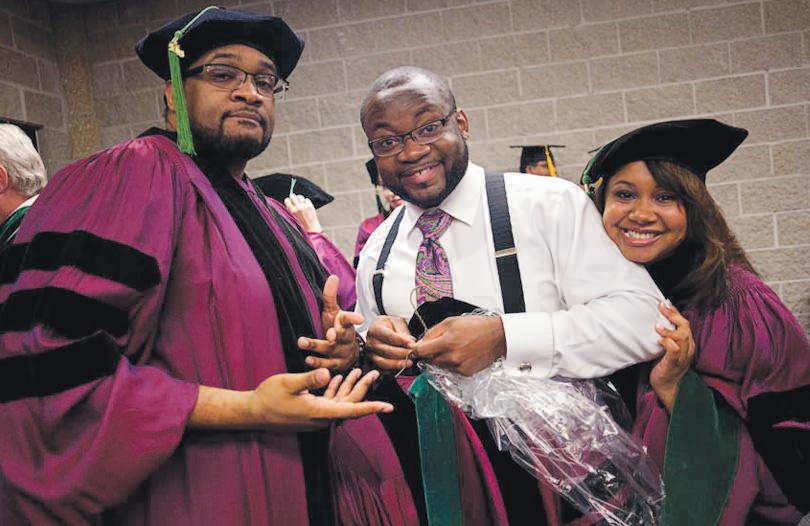
biology, pre-medicine.
Dr. Tolulope T. Oke will enter a family medicine residency at Indiana University Health Ball Memorial Hospital in Muncie in July. She is the daughter of Yemi Oke of Lagos State, Nigeria and the late Yele Oke. She is married to Edobor Efam from Benin City, Nigeria, and they have one child, Ayomikun Efam (3 years old). Oke is a graduate of Queen’s College in Lagos, Nigeria and Illinois State University, where she earned her bachelor’s and master’s degrees in chemistry.
Dr. Rosemary Owusu will enter a pediatrics residency at SIU School of Medicine and

its affiliated hospitals in Springfield in July. She is the daughter of George Owusu of Bronx, N.Y., and Irene Pokuah of Kumasi, Ghana. She is a graduate of Christopher Columbus High School in New York City and Georgetown University in Washington, D.C.
Dr. Aisha T. Pitts is the daughter of Denetrice Hill of Chicago. She is a graduate of Thornton Township High School in Harvey and Fisk University in Nashville, Tenn., where she earned her bachelor’s degree in biology and Spanish.
Dr. Keisha L. Powell will enter a psychiatry residency at
Southern Illinois University School of Medicine and its affiliated hospitals in Springfield in July. She is the daughter of Barbara Powell of Chicago. She is married to Pedro Martinez-Bravo from Chicago and they have two children, Dominique MartinezPowell (14 years old) and Yasmin Martinez-Powell (10 years old). Powell is a graduate of Lincoln Park High School in Chicago and DePaul University in Chicago, where she earned her bachelor’s degree in psychology.
Dr. Alexis Rivera will enter a pediatrics residency at SIU School of Medicine and its affiliated hospitals in
Springfield in July. She is the daughter of Luis and Deborah Rivera of Mt. Vernon, N.Y. She is a graduate of Mt. Vernon High School in Mt. Vernon, N.Y., and Concordia College in Bronxville, N.Y., where she earned a bachelor’s degree in biology.
Dr. Amanda Velazquez will enter an internal medicine residency at Indiana University School of Medicine in Indianapolis in July. Velazquez is the daughter of Rudy and Nancy Velazquez of Oak Park. She is a graduate of Oak Park River Forest High School and the University of North Carolina at Chapel Hill, where she earned her bachelor’s degree in nutrition.
Dr. Vance M. Washington is the son of Tony and Gloria Washington of Vallejo, Calif. He is a graduate of Vallejo High School and San Diego State University, where he earned his bachelor’s degree in biology.
Dr. Gisela K. Williams is the daughter of Eddie Williams of Beach Park and the late Kathleen Williams. She is a graduate of Woodlands Academy of the Sacred Heart in Lake Forest and Lake Forest College, where she earned her bachelor’s degree in Spanish. Established in 1970, SIU School of Medicine (www.siumed.edu) is based in Carbondale and Springfield and focused on the health care needs of downstate Illinois. It is specifically oriented to educating physicians prepared to practice in Illinois communities and has graduated 2,550 physicians since the first class in 1975.

By Benjamin Todd Jealous
Of The NAACP
“For a country regarded as the paramount leader in a multicultural world, the United States has yet to embrace its own diversity; continuing failure to do so will have profound consequences for governance.”
That quote came from a 1996 report
by
Allan
E.
ethnic gaps in our education system. Last week’s Supreme Court ruling on affirmative action reminded us that we have a long way to go.
“Student body diversity is a compelling state interest.”
–
Justice Sandra Day O’Connor
Goodman, former executive dean at the Georgetown School of Foreign Service. For decades, American leaders in business, education and economics have lamented the wide racial and
In the case of Fisher v. Texas, the Supreme Court ruled on the constitutionality of the University of Texas’admissions policy. The university currently allows admissions officers to consider an applicant’s race among a number of other qualifying factors. The Court voted to send the case back to a lower court of appeals. In doing so, they reaffirmed the use of race in admissions, and the importance of educational
diversity in the 21st century.
The decision in Fisher upheld an important precedent set in the 2003 case of Gruttinger v. Bollinger. In that case, Justice Sandra Day O’Connor refuted the idea that our society had advanced beyond affirmative action. She argued that the need for “cross-racial understanding” was still necessary to break down racial stereotypes, and that “student body diversity is a compelling state interest.”

Justice O’Connor’s argument was based on sound social research. In her words, “major American businesses have made clear that the skills
needed in today’s increasingly global marketplace can only be developed through exposure to widely diverse people, cultures, ideas, and viewpoints.”
Like Allan Goodman, Justice O’Connor also saw diversity as a national interest. This is even truer today. When Goodman wrote about the multicultural world in 1996, only one out of every 13 Americans had access to the Internet. Google, Twitter and Facebook were still rough ideas scribbled in students’ sketchpads. Seventeen years later, technological advances in communications, travel and trade have given rise to a new
era of globalization. Leaders in business and government need to know how to work with people of vastly different races, cultures and perspectives.
We will be stronger as a nation if we embrace our growing diversity and ensure that the pathways to leadership remain wide open. Numerous studies reveal that mere interaction is the best way to avoid intergroup conflict.
Sociologists have even found that diversity increases opportunities for creativity.
In light of the Supreme Court’s decision, America’s educational institutions should recommit to fair and thoughtful ways to foster diversity. In the coming months, the NAACPwill work with universities, policymakers, and
By American staff
Working in the St. Louis mortgage industry for over 30 years, Marion D. Clark takes time to listen to her clients to gain a deep understanding of their goals and needs. Using her experience, Clark takes pride in providing exceptional service and guidance in a variety of home finance options including Conventional, FHA, MHDC and VAloan programs to discover the best option for their individual needs.
The 2010 recipient of the Metropolitan St. Louis Equal Housing Opportunity Council Open Door Award, Clark is an active member of the community, participating in organizations like Better Family Life, Beyond Housing and the Urban League of Metropolitan St. Louis.
“In an ever-changing financial market, both locally and far reaching, Eagle Bank is a community bank with over 100 years of stability and quality service,” Clark says. “I am
proud to be working with a group of talented and trusted colleagues dedicated to helping our St. Louis community find stability within these turbulent times.”
The American asked her about some issues in banking and lending from her perspective as an AfricanAmerican banking professional.

The American: There have been decades of scandals about “redlining.” As a black lender, what can you do and have you done to counteract

this legacy of discrimination?
Marion D. Clark:
As a black lender I am very conscious of the legacy of discrimination. For that very reason, I consult with every client to discuss their concerns and needs. I also provide individual and group education.
The American: You must hear from black folks who doubt that they have a fair chance to get a fair loan. What do you tell such a person to convince them they have a fair chance to get a fair loan?
Marion D. Clark: Yes, there
are African Americans that have that doubt up front that they will be approved for a home loan. This is a challenge, but I approach this, again, by listening to their concerns, letting them know Eagle Bank and Trust and I do care. I work very closely with the processing and underwriting departments, and our focus is to approve as many loans as possible.
The American: Let’s play “Borrowing for Dummies.” What are a few essential things you must know and do when seeking a loan.
Marion D. Clark: The three essential things that the borrower must know and do when seeking a loan is: credit, quali-
the business community to see that qualified students from a diversity of backgrounds get a close look and a fair shot at admission to top schools.
Justice O’Connor wrote that “effective participation by members of all racial and ethnic groups in the civic life of our Nation is essential if the dream of one Nation, indivisible, is to be realized.” Our country’s pledge is to be one nation, and our country’s challenge is to lead a global economy that is increasingly flat. If America is to maintain its role as a moral and economic leader in the 21st century, we must build on our greatest strength: diversity.
Ben Jealous is president/CEO of the NAACP.
fying (debt-to-income ratios) and funds to close.
The American: You are a mortgage lender at a time when mortgage lending has made national headlines. What can and do you tell people scared to seek a mortgage because they have seen so many mortgages fail?
Marion D. Clark: Because of what has happened in the mortgage industry it’s very important to me to make sure they have an affordable mortgage loan program, and work with the people to make sure they are credit worthy. I hold their hand throughout the entire process, which causes a good experience and helps to get a loan closed.

By Rebecca S.Rivas Of The St.Louis American
St. Louis native Stephen Westbrooks has lived in many places. But he’s most passionate about St. Louis.
“St. Louis has a lot to offer,” said Westbrooks, an underwriter for Affordable Equity Partners. “It has a solid foundation and many interesting things that can grow from that.”
In particular, Westbrooks is working on growing community-development financing throughout the state with the firm Affordable Equity Partners.
Since 1997, Affordable Equity Partners has deployed federal and state tax credits for low-income housing and historic rehabilitation projects. The firm’s next step is to provide these communities with everyday services, such as grocery stores and health care centers.
Nine months ago, the firm hired Westbrooks to develop the New Markets Tax Credit program, which would provide tax credits for these necessities. Before coming back home, Westbrooks served as manager of a similar program for Seedco Financial in New York City. New Markets Tax Credits support mixed-use commercial areas in low-income or underserved communities. For Westbrooks, his new task couldn’t be a better match of his skill set and passion. And although he and his wife, Erica, enjoyed New York City, they were more hyped about their home town.

“We wanted to come back and plant our roots and use our energy in this community – the community that we are both from,” he said. “I had a great opportunity to immerse myself in community finance development with this project.” There isn’t a typical day for Westbrooks. Developing a brand new program requires him to wear quite a few different hats, he said. Part of his responsibility is putting together an advisory board, which requires outreach. He’s also working with attorneys to create an LLC that they are using as a vehicle to apply for the credits. Basically, once the program
is off and running, Affordable Housing Partners will apply to the state and federal governments for the New Markets Tax Credits. Then developers will go to the firm to propose various projects where those credits could be used.
“They come to us with investment opportunities,” he said. “We are the ones who decide which projects get that equity.”

‘Coopetition’
Although Affordable Housing Partners has a standing reputation for other tax credit programs, it faces some competition in this new market.
“It’s interesting,” he said. “I would describe the New Markets Tax Credit industry as more of a ‘coopetition,’if you will – joining the words cooperation and competition.”
There’s a competitive bidding and application process that all entities go through to apply for the credits through the federal government. Yet once the credits are received, there is a lot of cooperation to complete the developments, he said.
“Ultimately, the community works together for the benefit of the low-income communities that are the targeted beneficiaries of the New Markets
Tax Credit program as a whole,” he said. For him a successful program would not only receive tax credit allocations but also deploy them in the low-income communities that the firm serves through its affordable housing practice.
“If I look up a year from now, I would love to have invested those credits to benefit the community and provide the retail, commercial and health care services in a meaningful way in the communities currently underserved,” he said.
“That’s my goal, and that’s what drives me to do what’s necessary to develop this program.”
Playing matchmaker
One of the first things Westbrooks did upon arriving in St. Louis was reconnect with the Regional Business Council (RBC)’s Young Professionals Network (YPN).
“I was probably back three days, and I was at an YPN event to get involved in the community,” he said. “They provide that platform very readily. It’s a generous network. You quickly get out of it more than you can possibly put back in.”
While in graduate school at Washington University, Westbrooks got involved in the RBC’s mentoring program. Before Seedco Financial, Stephen served as manager of corporate development for the local investment firm, Cequel III.
“It helped me get job opportunities from networking directly out of grad school,” he said. “The network is active in playing matchmaker, making connections that make sense and carving out opportunities for everyone.”

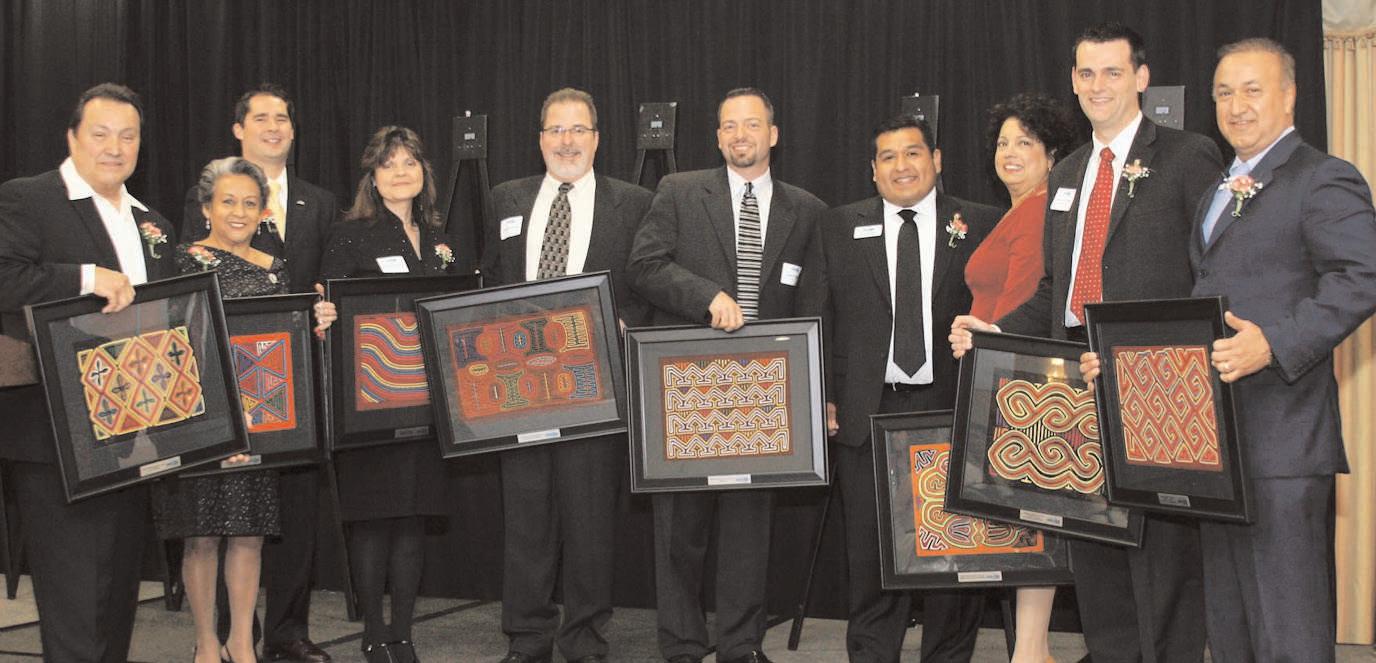
Eight St. Louis community businessmen and companies were recognized by the Hispanic Chamber of Commerce of Metropolitan St. Louis on April 26 at its 31st Annual Adelante Awards dinner at the Sheraton Westport Chalet.
Award winners were:
Hispanic Businessperson of the Year - Arturo Latimer, Gibson Printing
Hispanic Chamber of Commerce Member of the Year - Castor Armesto, Stinson Morrison Hecker LLP
Hispanic Emerging Business of the Year - La Cantina
Hispanic Business Advocate of the Year - AT&T
Hispanic Company of the Year - NextGen Information Services Hispanic Lifetime
“These individuals have contributed to the betterment of not only the Hispanic community but the St.Louis community at large.” – Karlos Ramirez
Achievement Award - Ampy Kollman-Moore Civic Award of the Year -
Virginia Braxs, Hispanic Arts Council Hispanic Chamber of
Commerce President’s Recognition – Centene Corporation
“The Adelante Awards are a way to celebrate and recognize the achievements of individuals, entrepreneurs and corporations in the metro St. Louis Area,” said Karlos Ramirez, Hispanic Chamber of Commerce executive director.
“The awards focus on individuals who have contributed to the betterment of not only the Hispanic community but the St. Louis community at large.” Incorporated on April 28, 1982, the Hispanic Chamber of Commerce of Metropolitan St. Louis strives to promote the economic development of Hispanic-owned businesses and improve business opportunities for all in the St. Louis region. Visit www.hccstl.com.

By Sandra Jordan
Of The St.Louis American
Calling 9-1-1 during emergencies has become instinctive in cases of medical crisis, bodily harm or property endangerment. Who gets the call when the crisis involves mental illness? In Eastern Missouri, it is Behavioral Health Response, known as BHR. It is a professionally staffed, accredited clinical call center based in Creve Coeur.
health services to the residents of the city of St. Louis and the Missouri counties of St. Louis, St. Charles, Franklin, Jefferson, Lincoln, Warren, Iron, St. Francois and Washington.
“For this past year, we averaged 17,500 calls per month,” Coleman said.
“We are looking for people with people that at the top of their list, because they know they will come here to save lives.”
– Patricia Coleman, Behavioral Health Response
“We provide expert behavioral health, crisis response and corporate feedback services, 24 hours a day, seven days a week, to agencies and companies worldwide,” said Patricia Coleman, president and CEO.
“They can call us directly through our crisis hotline at 314-469-6644 or 1-800-8114760, and it’s free of charge for residents.”
BHR provides confidential telephone counseling to persons who are experiencing mental health crises. It also offers mobile outreach, community referral and critical incident stress management.
BHR’s call center workforce consists of about 100 paid professional staff with at least master’s level degrees in behavioral science disciplines. Its Access Crisis Intervention provides aroundthe-clock access to mental
“And then, you know, we provide face-to-face mobile outreaches where the clinicians will go into the homes, the hospitals and places that are not restricted, and we’re averaging 200 of those per month.”
She said BHR is growing and so is the need for its services.
For example, a call may come into the crisis hotline. A clinician will conduct an assessment via the telephone. That clinician makes the decision whether the situation warrants a face-to-face mobile outreach. If needed, the mobile outreach clinician on call can go to a home and conduct an in-person assessment.
“Our job is to divert people from the hospital,” Coleman explained, “but if the need should rise, we will help them and link them to the hospital or to other services in the community to get them some help.”
‘Diverse in all ways’
She said it is through
BHR’s employee referral program that organizational diversity and inclusion is promoted.
“We feel we have a diverse workforce. Our network of employees help keep a pipeline of talented, qualified candidates,” Coleman said. “It’s diverse in all ways – race, gender, age. Right now our HR department is doing an extra effort to recruit veterans – that qualify, of course – and people with disabilities.”
Recruiting professionals with the right mix of master’s level education and above, along with the clinical expertise, can be difficult, but Coleman said BHR is committed.
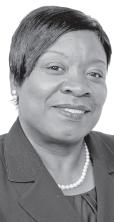
“Number one, we are looking for people with people that at the top of their list, because they know they will come to work here to save lives,” Coleman expounded.
“Also, we have to find people who have very good clinical skills. They work at a call center, so personal skills are very important; and you must be able to work as an individual and also as a team player.”
Collaborative effort
Leaders from four area community mental health service providers founded BHR in 1995 as a private, non-profit organization in order to create a comprehensive crisis inter-

vention system for the eastern region of Missouri. They are Crider Health Center, BJC Behavioral Health, Amanda Luckett Hopewell Center and Community Treatment, Inc., known as COMTREA. Executives from the organizations serve on the BHR Board of Directors, along with four additional board members added last year: CEOs from the Independence Center, Places for People, Queen of Peace and Bridgeway Behavioral Health.
In 2005, the BHR board incorporated BHR Worldwide, a for-profit subsidiary, Coleman said, “to preserve and protect the public mission of the parent company and to facilitate contingent growth in the private sector.”
Right now, Coleman said BHR’s for-profit business mix consists of employee assistance programs, corporate communications, behavior health, crisis intake and consultation, chemical dependency intake, and a recent expansion into hospital emergency departments with an eClinician service.
“We provide clinician services to hospitals and EDs across the country,” Coleman said. “This service provides assessment and case management services in hospitals 24/7
via telehelp video conferencing.”
STLCounty partnerships
BHR has a St. Louis County Youth Connection Helpline, a partnership with Youth in Need that is funded by St. Louis County Children’s Services fund.
“It’s a 24/7, one-stop access point for children, youth and families in St. Louis County,” she said. “They can text 4HLP, to 31658, or the telephone number is 314628-2929 or toll free 1-877928-2929.”
Another important BHR service is mental health first aid training, which is also a part of a St. Louis County grant.
“It’s designed to increase knowledge, reduce stigma and offer appropriate supports to individuals experiencing a mental health crisis,” Coleman said.
“We are going into our second year of that as well and it’s free of charge to individuals who live in St. Louis County, work in St. Louis County and/or serve or interact with St. Louis County children or youth.”
For more information, email
trainings@BHRWorldwide.co m or register at www.BHRSTL.org.
There since the beginning Coleman has been with BHR since its inception 17 years ago. Last December, she became BHR’s president and CEO. Coleman, a St. Louis native, earned an MBAat Fontbonne College and a BAfrom Saint Louis University. She

By Rebecca S.Rivas Of The St.Louis American
Sometimes minority business owners run out of ideas and connections to take their businesses to the next level.
they may have never considered doing.”
The event brings together MBEs, private equity capital providers, along with diversity professionals that are interested in growing minority businesses.
“We are investing in minority companies that are creating jobs in the minority community throughout the country.”
of BAMLCapital Access Funds (CAF), a division focused on private equity investing in emerging and underserved U.S. markets.
Craig Fowler, a managing director at Bank of America, has been working with minority businesses for a long time and understands the potential challenges. One of his most recent initiatives to help minority businesses nationwide grow to scale is the M&AMinority Business Enterprises Summit, an annual event held at Bank of America’s headquarters in New York City.
– Craig
Fowler, Bank of America
Oftentimes, Fowler said what’s missing from the conversation are corporate development players – people who work with vestitures. He gave this example. When Monsanto spun off its NutraSweet division and Arnold Donald bought it, that created a minority-owned business of significant size.
“It helps educate minority business owners to consider acquisitions and mergers, as a way to use private equity to build their business,” Fowler said of the summit, “which
Continued from page 34
cesses have been training all leaders on disability and inclusion regarding hiring individuals and caring for patients with disabilities. We’re still in the process of training all coworkers on working with and caring for patients with disabilities.
“We invite major corporations to this event, so we can find out if they have the vestiture opportunities that a minority business owner could buy,” he said. “And then we have private equity capital providers there that could help them.”
At Bank of America, Fowler is a managing director
The American: What exactly does the Diversity and Inclusion Oversight Committee do? Does it have data-based goals it oversees and monitors?
Frank Lenior: The Diversity and Inclusion Oversight Committee is accountable for fulfilling the Diversity and Inclusion Plan. The Diversity and Inclusion Oversight Committee duties include recommending policy statements and diversity pro-
Fowler’s team manages capital for the bank but also for some public pension funds. CAF has managed and advised on over $1.1 billion of capital since 2002.
Fowler said the CAF team focuses on a double bottom line – economic and social impact.
“What we’ve been able to do on a national basis for the last several years is invest in private equity funds that are targeting these underserved markets and actually helping to create jobs throughout the country,” he said, “and helping to create wealth for ethnic minority and women professionals.”

ment officer with the bank’s Small Business Investment Company. In this role, he made mezzanine and equity investments in small and minorityowned businesses throughout the Midwest.
“Being a person who has always been community-minded, the economic development aspect appealed to me,” he said.
Before joining Bankof America, Fowler was a corporate relationship manager and vice president with Mercantile Bank (now US Bank), lending to small and middlemarket companies.
Fowler joined Bank of America in 1997 as an invest-
grams to effectuate the Diversity and Inclusion Plan, and in conjunction with Marketing and Communications Department, developing and executing internal and external communication.
That includes dissemination of the Diversity and Inclusion Mission Statement throughout Mercy to co-workers, patients, visitors, prospective co-workers, contractors and vendors. It also includes assisting leader-

work working with minority business owners,” he said. “And I was able to do a lot in that area to help start and grow businesses.”
When he made the switch to work in private equity funds, he said he expanded his business skills as well as his network relationships.
“It took me to being focused globally,” he said. “It is a continuation of my work with minority businesses in the Midwest. We are investing in minority companies that are creating jobs in the minority community throughout the country.”
Fowler serves on the board of the National Association of Investment Companies (NAIC), the industry association for investment companies dedicated to investing financial resources in an ethnically diverse marketplace.
During his 15 years in commercial banking, he said he became somewhat of a specialist in private, federal, state and local programs geared toward economic development.
“I developed a strong net-
ship in implementation of Mercy Diversity and Inclusion Plan and in arriving at solutions to any perceived impediments.
The committee also reports information that will measure the effectiveness of the Diversity and Inclusion Plan, identify areas with opportunities for improvement and provide all required statistical reports and documentation to hospital administration.
The committee also per-
However, Fowler is also tireless in his work to grow minority business locally. In 2006, Fowler helped to found the Center for the Acceleration of African-American Business, and he still sits on its executive leadership team.
He also serves on the board
forms periodic reviews of hires, promotions, terminations, job classifications, management and supervisory practices, work assignments, training, and other terms and conditions of employment as necessary, to ensure adherence to the goals of the Diversity and Inclusion Plan.
It also ensures that the Diversity and Inclusion Plan’s Mission Statement is identified and posted throughout the hospital and keeps leaders
of the St. Louis Local Development Company, the city agency that oversees the SBA504, Micro Loan and Urban Enterprise Loan programs. And he is a board member of various private equity portfolio funds’advisory boards. Fowler holds a BS in business administration from the John M. Olin School of Business at Washington University, and he is a graduate of the Venture Capital Institute. As an alum, he said he nudges the university to keep focusing on entrepreneurship in its courses. Fowler encourages students who are interested in becoming an entrepreneur to learn business through internships or working with a large company.
“There’s a need for entrepreneurship more so than when I was in college,” he said.
“I was educated to some extent to go work for a corporation. Those opportunities have changed. There is more of a need for individuals to look at other avenues. For those who have the mentality to start their own companies, they should explore it.”
informed of the latest developments pertaining to diversity and monitors best practices in diversity and inclusion.
The American: Has the Minority Mentoring and Leadership program led to any African Americans moving up at Mercy? If so, tell us a story. Frank Lenior: We are in the first year of the mentoring program but are hopeful the mentoring program will provide an avenue for promotions.

American staff
Navy Counselor First Class Shaunell Hyatt, a St. Louis Sailor, was presented recently with the 2012 Award of Excellence from The Navy League of the United StatesSt. Louis Council, in addition to being named 2012 District Sailor of the Yearfor Navy Recruiting District St. Louis.
NC1 Hyatt received both awards based on his leadership, teamwork and job performance, as well as local community involvement.
Nominated by his command, NC1 Hyatt was chosen from a pool of outstanding active and reserve duty personnel from the Navy, Marine Corps and Coast Guard. An officer and an enlisted service member from each service were recognized for their contributions to their respective branch, as well as the St. Louis community.
have otherwise been afforded.
“My original plan was to get in and only do my four years, but once I got into the Navy, I quickly realized that the lifestyle was for me,” said NC1 Hyatt.
“I wanted to give kids the opportunities that were afforded to me.”
– Navy Counselor
NC1 Hyatt was first stationed aboard USS Enterprise (CVN-65) in Norfolk, Va., and participated in a humanitarian mission to the Mediterranean, during which he provided food and supplies to those in need. His most memorable moment aboard USS Enterprise was during the September 11, 2001 attacks on the United States. “It was absolutely chaotic,” said NC1 Hyatt. “I was 18 at the time. I was incredibly scared, but ready to take on whatever missions were handed to me.”
NC1 Hyatt was recognized as one of the most accomplished and successful recruiters in NRD St. Louis, which culminated in him being named District Sailor of the Year. Immediately following his graduation from North Jackson High School at the age of 17 in 2000, NC1 Hyatt went to his local recruiting station and signed up for the Navy as an undesignated Airman. He decided to join because he felt the Navy could offer him a wealth of job and educational opportunities, as well as adventures that he would not
In 2003, NC1 Hyatt attended an electrical engineering program in Great Lakes, Ill., and was then stationed aboard USSBataan (LHD 5), also in Norfolk, Va., as an Electrician’s Mate Fireman. He completed two more deployments including another mission to the Mediterranean, and also participated in Operation Caribbean Lion, a goodwill mission featuring training exercises with the navies of countries from throughout the Caribbean.
It was also while aboard USSBataan that NC1 Hyatt was sent to New Orleans, La., to participate in the clean-up efforts following Hurricane Katrina. He was responsible for rescuing stranded individu-

als, directing traffic and cleaning up debris.
As the first person in his family to venture outside of the country, NC1 Hyatt was able to travel to a variety of countries including Spain, Italy, St. Thomas, Malta and many more. Although he enjoyed traveling, he was ready to be stateside and spend more time with his family.
“I wanted to be near my family, but a main driver for me was the opportunity to give

back,” said NC1 Hyatt. “I wanted to give kids the opportunities that were afforded to me.” In 2006, NC1 Hyatt moved to Nashville, Tenn., where he served as an active duty recruiter until he moved to St. Louis in 2010, where he has been stationed ever since. NC1 Hyatt still keeps in touch with many of his recruits, and has even recruited two of his cousins to be in the Navy. In addition to his work with
the Navy, NC1 Hyatt is very involved with his local community. He volunteers with the Girl Scouts of America, as well as a program called Pathways, which provides support to veterans in area hospices. NC1 Hyatt joins other volunteers in presenting veterans with banners, listening to their stories and letting them know how much they are appreciated.
While he enjoys his work and volunteer activities, NC1
Hyatt’s most important job is as a husband and father. He has been married to his wife, Melanie, for more than 10 years, and she is currently a stay-at-home mom who home schools their four children – 9year-old Christian, 7-year-old Sydney, 5-year-old Kennedy and 1-year-old Tyler.
“Without my wife, I wouldn’t be where I am today,” said NC1 Hyatt. “She is the biggest support I have. My wife has made me who I am.”

By Peter Baugh
For The St.Louis American
From the moment St. Louis Blues fans walk into the doors of the Scottrade Center until the minute they leave, Lamont Buford is in charge of keeping them entertained.
“Everybody would love to win every game, but you also like to see how players handle adversity as well.”
Buford, the director of game presentation and amateur hockey for the Blues, has many responsibilities, including coordinating every game’s music and videos.
– Lamont Buford
“During the regular season, it’s just basically implementing those plans that you put together during the summer time as well as coming up with
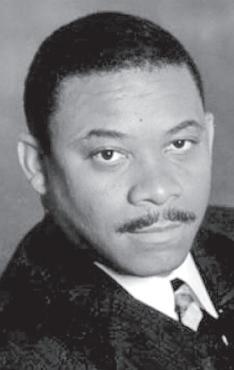
some new ideas,” Buford said. For this aspect of his job, Buford has the opportunity to do what many Blues fans dream of: to be around professional hockey players. He says he has plenty of interaction with the players, especially at the start of the regular season. He said he finds the athletes cooperative and easy to work with. “At the beginning of the year we are trying to film them and get them ready for their headshots and any video features that we do,” he said. “We try to make sure that we have a good relationship with the players.”
Ultimately, however, he
works to please the fans. In terms of game presentation, he likes seeing fans react to what he does, especially when he feels he is giving people a break from hardships in their everyday lives.
“The crowd influences just about everything that goes on in a game,” Buford said. “The players feed off the crowd, and so do we.”

In his capacity of director of amateur hockey for the Blues, he organizes a variety of youth programs.
“For the amateur hockey, I handle coordinating all of our
youth hockey initiatives,” Buford said. “That includes our youth hockey camps, our rink partnership programs.”
Before the NHLseason rolls around in January, Buford mostly works on the youth hockey side of his job.
“I enjoy being able to work with the youth hockey community; it’s just a great community to work with,” he said.
Buford also blogs about youth hockey on the Blues website, blues.nhl.com. “Ice hockey, like every top-level sport, requires big commitment
from both parents and players,” he wrote in a recent post.
Buford works in the organization’s marketing branch.
Though he says he is one of few African Americans in the Blues’administration, he does feel there is plenty of diversity in the organization.
“There’s so many different countries represented,” he said.
“We have guys who are from Russia, from Czechoslovakia, Canada; we also have guys from the U.S.”
The Blues has AfricanAmerican inclusion at the top as well. David Steward, founder and chairman of World Wide Technology, is part of the new ownership group that kept the Blues in St. Louis.
Buford was not initially a hockey fan. He played football, basketball and track growing up. In fact, he did not get interested in hockey until
after college, when he spent over six years working for the Hershey Bears, an American Hockey League team, before getting an opportunity in St. Louis.
Working with the Blues, Buford gets to be around the sport he has fallen in love with played on its biggest stage.
“I love to see the win and the reaction of the fans and the players. I like to see when they score goals,” he said. “Of course, everybody would love to win every game, but you also like to see how players handle adversity as well.”
What advice does he have for someone who aspires to work in a similar position?
“If someone is really interested in being in this field,” he said, “you have to be very creative, have a wild imagination and be prepared to work extremely hard.”
Was a fierce education advocate who mentored at-risk youth
Southern Illinois University Edwardsville and the Construction Leadership Institute (CLI) Advisory Board presented a plaque honoring the contributions to the St. Louis community by late CLI graduate Tyrone Thompson at the 10th anniversary celebration of the CLI program on May 8. Thompson’s mother, former state Rep. Betty Thompson, accepted the award.
Tyrone Thompson was a member of the Kwame Building Group and graduated from the inaugural program of the CLI in 2004.He was a fierce education advocate who mentored hundreds of at-risk youth.
Thompson was tragically shot by two teenagers in an attempted robbery in 2010. At the time, he was developing a
Thompson was tragically shot by two teenagers in an attempted robbery in 2010.
mentorship program through University City High School. The Kwame Building
Group continued his work by creating the Tyrone Thompson Institute for Nonviolence, which offers an innovative approach to school suspensions. Through the foundation, college students are trained to provide one-on-one mentoring in a student’s own school setting, and support skills workshops are made available to parents. CLI was created 10 years
ago when building industry leaders approached SIUE to help create a program to accelerate the leadership development of high potential employees. It resulted in collaboration between the SIUE Schools of Business and Engineering to offer an annual program of nine weekly, day-long sessions from mid-January through mid-March.
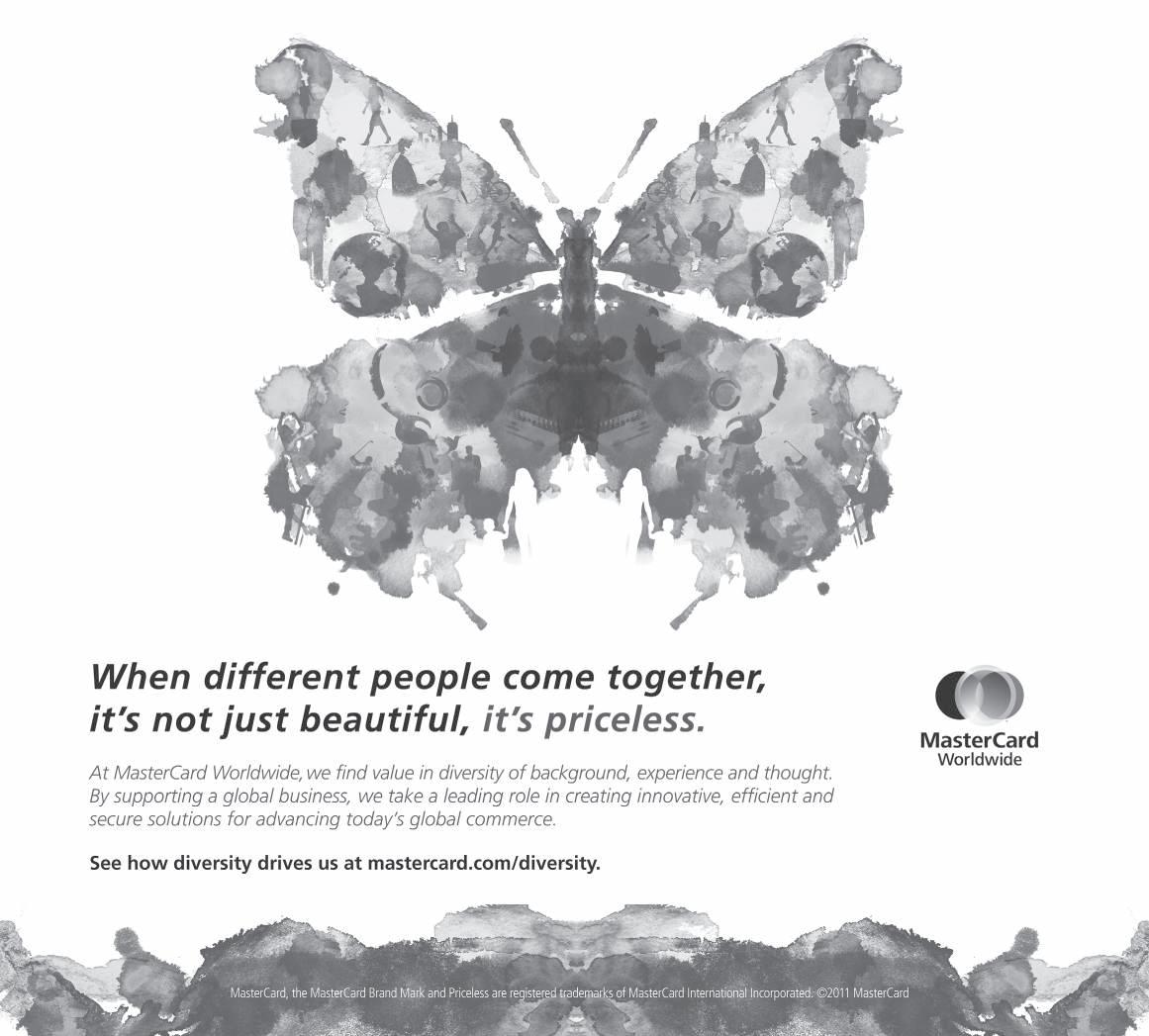
American staff
Holding a baby mannequin in both arms like a pro, high school student Taylor Robinson takes in all the sights and sounds of the simulated nursing lab on Tuesday at Southern Illinois University Edwardsville. Robinson, a 16year-old student at Edwardsville High School, was one of 19 high school students who participated in the weeklong SIUE Healthcare Diversity Summer Camp, which was held June 17-21.
Area high school juniors and seniors with an interest in health care came to the University on June 16 to get exposure to SIUE’s Schools of Pharmacy, Nursing and Dental Medicine. The health care professional schools targeted minority students because they understand the need for more diversity in these fields, said Dr. Lakesha Butler, clinical associate professor in the School of Pharmacy and current coordinator of the diversity summer camp.
cy school. Four years later, the program has seen great success and has expanded into a sixday, inter-professional program. Thanks to funding from Walgreens, Express Scripts and Target, high school minority students have the opportunity to live in the residence halls and learn about the professions of pharmacy, nursing and dental medicine at no charge to the students’families.
“Without this partnership, the opportunities provided to these students through the health care diversity camp would never have happened,” said Dr. Mark S. Luer, associate dean of professional and student affairs in the School of Pharmacy.
With funding from Walgreens, Express Scripts and Target, minority students live in the residence halls and learn about the professions of pharmacy, nursing and dental medicine at no charge.
In 2009, the SIUE School of Pharmacy established a three-day, non-residential summer camp for high school seniors interested in pursuing a pharmacy degree. Recognizing the value of increased diversity in the Doctor of Pharmacy student body, the school created the camp as an opportunity to expose students to careers in pharmacy and guide them along their journey to pharma-
Students spent their first day at camp touring the SIUE campus and learning about student resources available at the University. On Tuesday, students spent the day in the School of Nursing, including the Simulated Learning Center for Health Sciences Laboratory. Sheila Pietroburgo, coordinator of the Skills/Simulation Lab, explained how SIUE nursing students learn needed information and gain valuable experience from work in the laboratory and with the simulators. They also learned about careers in nursing and met with key faculty members. Students visited the School of Dental Medicine in Alton on Wednesday. They toured the campus and participated in hands-on anatomy and physiol-

ogy activities, including inspection of their own cheek cells under a microscope, an xray review of cavities and electronic cadaver simulation. Students also created impressions of teeth models in the School’s Multidisciplinary Lab. Dr. Cornell Thomas, assistant dean for admissions and student services, led a discussion about dentistry as a career and the School’s admissions requirements. Thursday was spent learn-
ing about careers in pharmacy. Activities in the School of Pharmacy included touring the School and hearing about memorable patient moments and sharing lunch with faculty members. Students had the opportunity to try their hand at various assessment skills in the Advanced Pharmacy Practice Lab including blood pressure, pulse, glucose, heel scan, cholesterol and inhalers. They also attended community pharmacy site visits at Maryville
Pharmacy, Walgreens and Schnucks Pharmacy.
The last day of the camp was focused on helping students prepare to take the ACT.
“Not only do we recognize the value of increasing the diversity in our student body, we also recognize the need to help prepare minority students to get to the finish line,” Butler said.
The opportunity to explore careers in health care and experience life on a college campus was inspiring for the
students. “The students are so motivated and driven,” Butler said. “I’ve been impressed with their interest and the types of questions they have asked.”
Tracee Williams, a 17-yearold student at Belleville West High School, said she is considering attending SIUE to major in nursing or pharmacy. “I didn’t think I wanted to go to SIUE because it was close and my mother graduated from here,” Williams said. “But I’ve found out that it’s a really good school.”Williams’ mother, Yvette Sanders, graduated from SIUE with a bachelor’s in business.
Christian Watts, a 17-yearold at Hazelwood Central High School in St. Louis, is considering a career as a pharmacist.
“Ever since I was young, I wondered how a small pill could make someone healthy.” Robinson is considering three areas of study: optometry, dermatology and oncology. “I think the eye is an intriguing thing,” he said. “The skin is a beautiful thing to me, and oncology research is interesting.”
Winston Jackson, however, is interested in becoming a neurologist. The 17-year-old Edwardsville High School student said the weeklong workshop has proven to be important and useful.
According to Luer, the camp was designed to encourage minority students to explore all types of professional careers. “This was a university-wide, interprofessional effort,” he said. “If we can inspire these students and equip them with the confidence they need to pursue a professional education and a career in a health care field, then the camp was a success.”

By Bridjes O’Neil
Of The St.Louis American
“When it comes to corporate banking, institutional banking or retail management, that is where the opportunity really lies.”
– Adewale Soluade, Commerce Bank
Adewale Soluade’s whole life seems to revolve around diversity – not only professionally, but personally as well. He’s feeling right at home at Commerce Bank as the its newest Diversity and Inclusion and Organizational Development Representative, a position he began in June. His responsibilities include providing leadership, coordination and strategic planning for diversity and inclusion initiatives, facilitating diversity and inclusion training, fostering strategic alliances with diverse organizations in the community, and supporting the work of the Diversity and Inclusion Council for Commerce Bank’s St. Louis market.
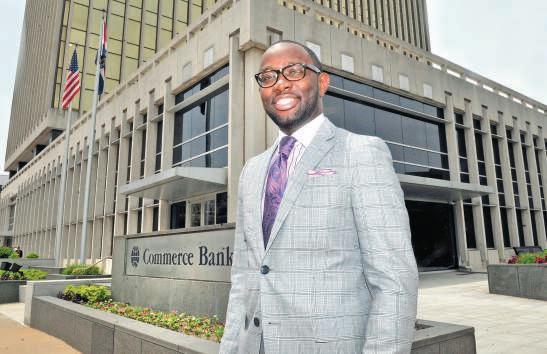
by Wiley Price
Adewale Soluade is Commerce Bank’s newest Diversity and Inclusion and Organizational Development representative.
“While building a diverse workforce has been a priority for Commerce Bank for several years, our formal program
was started in 2010 when we launched our Diversity and Inclusion planning process that led to the formation of our council, the development of a business plan, and the hiring of a team member to help coordinate and expand
Conversation between David Steward and the president of Harris-Stowe
By Rebecca S.Rivas Of The St.Louis American
“There’s talent at the HBCUs that aren’t being utilized and fully accessed.” – David Steward
our efforts,” said Sara Foster, chief Human Resources offiSee STEWARD, page 53 See SOLUADE, page 53

Vianey Beltran has joined the Hispanic Chamber of Commerce of Metropolitan St. Louis as the new assistant director.

Beltran is a recent graduate of Truman State University and is currently pursuing her master’s in public affairs at the University of Missouri Columbia.
“We are so pleased to have Vianey join our team at the Hispanic Chamber,” said Karlos Ramirez, executive director of the Hispanic Chamber of Commerce.
“We think her educational background in public policy will provide a good platform for her to carry out the Hispanic Chamber’s mission and promote Hispanic businesses, which will in turn benefit the entire St. Louis community.” Incorporated on April 28, 1982, the Hispanic Chamber of Commerce of Metropolitan St. Louis strives to promote the economic development of Hispanic-owned businesses and improve business opportunities for all in the St. Louis region. For more information, visit www.hccstl.com.
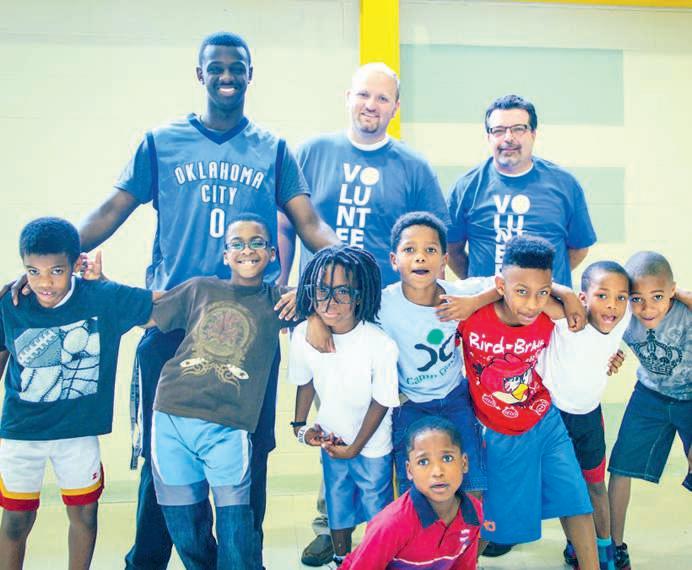
Wal-Mart volunteers recently joined Camp Classic for a fun-filled day of learning.Operated by the St.Louis Gateway Classic Sports Foundation, the camp offers Debate Team,Academic Learning Stations,Financial Literacy,Glee Club,Performing Arts,a STEM program and weekly visits to off-site venues.“Activities at Camp Classic are tailored to provide experiences that give youth opportunities to be involved with learning,to discover new ways of learning and have a great time while enhancing their academic skills,”said Richard Gray, president of the Gateway Classic Foundation.

Continued from page 49 this exchange as well: innovation.
In June, Harris-Stowe State University hosted a U.S. Small Business Administration daylong seminar, where Steward and the SBA’s national administrator Karen Mills spoke together about the agency’s resources.
Yet before Steward stepped on stage, he met in a board room with Mills and the university’s president Albert Walker. The three got into an impromptu, animated conversation about how to teach the next generation entrepreneurship.
Steward told them about an intern who created a special software application for his company.
“It’s revolutionary,” he said. “He put together 35,000 lines of code. We use it in our business propositions now, helping companies upgrade their Windows program. He was a college student. And now he is on staff fulltime.”
Albert Walker has been president of Harris-Stowe for a little over a year now, and he said he made an important change at the university. He’s requiring every single student to participate in an internship before they graduate.
“Students are saying, ‘I can see what I am capable of doing,’” Walker said.
Steward told Mills about a fresh collaboration that his company is about to enter into with Harris-Stowe and the Missouri National Guard regarding cyber security.
“This would be a model for generating the next generation of cyber warriors,” Steward said. “It’s a huge deal that we are putting together right now under WWT’s contracts. We are working on a memorandum of understanding right now to define what this looks like.”
Mills praised the idea.
“Cyber warfare is a huge opportunity,” Steward said. “Protecting the infrastructure of this country is vitally important. It’s important that we do this across the country. There’s talent at the HBCUs that aren’t being utilized and fully accessed.”
“This is a tremendous opportunity for us to pull that underutilized resource and train and develop it. At the same time getting them involved in the defense of this country.”
Walker said students need to get exposed to the world, rather than just going back to their communities. First-generation students are often rough around the edges, he said.
“I’m one of those old-time presidents who will say to a student, look come here,” he said. “I’ve pulled out a wallet, and told them to go out to the store and buy a suit. When students look, walk and talk like the persons they want to work with, that makes a big difference in confidence.”
Mills said there’s a role for entrepreneur training at a young age. SBAhas started to collaborate with community colleges to teach entrepreneurship. SBAalso hosts classes so people can just understand the basics. What is a business plan? How do you measure your profit and loss?
“Accounting is a language and if you don’t know the language, you can’t play,” she said. “We talk about adding another ‘E’to STEM, so it’s science, technology, engineering, entrepreneurship and math.” Steward agreed.
“This needs to start at a younger age,” he said. “My father was the first entrepreneur I ever saw. I watched him and I said, ‘I want to be just like him.’”
Continued from page 49
cer of Commerce Bancshares, Inc.
“We feel confident in our strong foundation of diversity and inclusion practices at Commerce and look forward to expanding our efforts in the coming years.”
Soluade intends to be a part of that expansion.
“Diversity and inclusion are two separate things,” Soluade said. “You can hire a bunch of diverse people, but if you don’t know what to do with them and how to foster that, then you’ve really just wasted your time.”
He comes from a diverse background, hailing from Nigeria. “There are over 250 different ethnic groups, which has created a country with a very rich, diverse culture,” he said of his home country in West Africa.
After graduating from high school in Nigeria at 16, he began researching colleges stateside and in the United Kingdom. He attended the University of Central Missouri (formerly Central Missouri State University) near Kansas City, where he earned a bachelor’s of science in Business Administration. He then obtained his MBA, with an emphasis on Leadership and Management, from Fontbonne University.
After living in the region for awhile, he has had time to observe and rate how well St. Louis recruits and retains diverse banking professionals. On a scale of one to 10, he scored it right down the middle.
He said that St. Louis is comprised mostly of small banks geared toward a specific clientele; however, in some cases, the composition of those in leadership positions doesn’t reflect the communities these banks serve.
“Most branches are diverse when it comes to tellers and
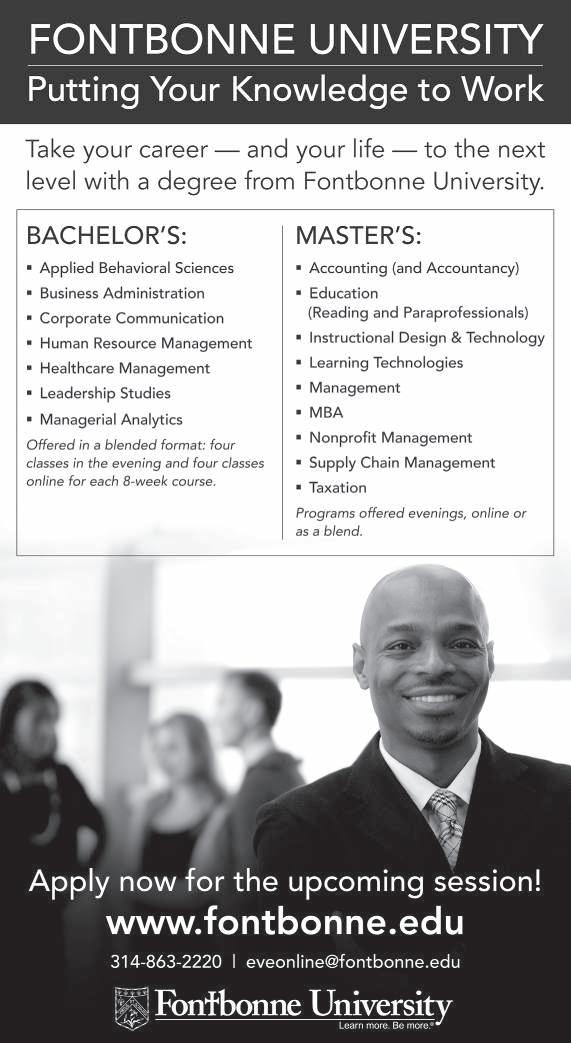
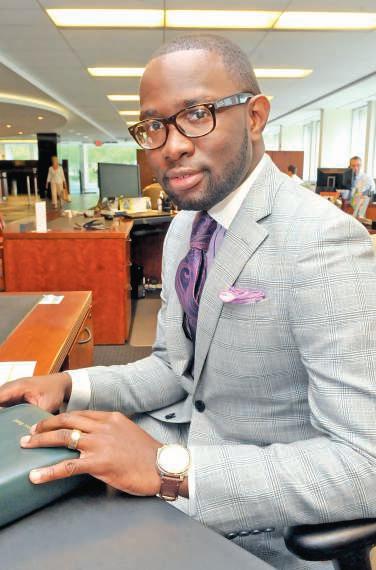
As Diversity and Inclusion and Organizational Development representative for Commerce Bank, Adewale Soluade provides leadership,coordination and strategic planning for diversity and inclusion initiatives, facilitates diversity and inclusion training,fosters strategic alliances with diverse organizations and supports the work of the Diversity and Inclusion Council for the St.Louis market.
bankers,” he said. “When it comes to corporate banking, institutional banking or even just retail management, I think that is where the opportunity really lies.”
Diversity and inclusion initiatives at Commerce Bank create and support opportunities for growth and development of its employees, which is accomplished by sponsoring participation in community leadership programs, Foster
said. Soluade is an alumnus of two such programs, the St. Louis Business Diversity Initiative Fellows and the Emerging Leaders Program, one of the leadership programs offered by FOCUS St. Louis. He’s a member of the Urban League Young Professionals of Metropolitan St. Louis and Regional Business Council –Leadership 100, among numerous additional affiliations.
He previously served as assistant vice president-branch manager at PNC Bank. Prior to that position, he was an assistant branch manager at PNC Financial Services. There, he was promoted to assistant vice president-branch manager from assistant branch manager after only three and a half years with the bank.
“I’ve always been really focused on what I want to achieve and where I want to be at certain points in life,” he accounted for his success. “I focused on making sure I was building the right relationships and really learning the things I needed to learn.” It was at PNC Bank where he gained most of his professional diversity-related experience. He led PNC Bank’s African-American Employee Business Resource Group for St. Louis. He served as the bank’s liaison on the St. Louis Regional Unbanked Taskforce steering committee as well as the St. Louis Metropolitan CRAAssociation. He engaged himself with the community, educating low-to-moderate income communities on financial literacy.
Commerce Bank’s St. Louis market encompasses nearly 182,000 households throughout the St. Louis region, that include seven counties and the City of St. Louis, Foster said. The Missouri-based company, with headquarters in Kansas City and St. Louis, operates in five states throughout the Midwest. Commerce Bank ranked eight on Forbes’2013 Best Banks in America list. This is the fourth year in a row Commerce Bank has ranked in the top 10.
“At Commerce, we are very intentional about creating an inclusive workplace and maintaining a culture that supports that commitment,” Soulade said. “We are engaging leaders across the organization in the conversation and equipping them through ongoing workshops that continue to build their self- and other-awareness, capacity and competency.”

By Chris King Of The St.Louis American
Georgetown University’s McDonough School of Business has joined the Consortium for Graduate Study in Management, a national not-for-profit organization focused on diversity and inclusion in American business. The addition of Georgetown, which becomes official on July 1, brings The Consortium’s member school total to a historical high of 18.
The Consortium will begin recruiting prospective MBA students for Georgetown McDonough in the fall of 2013, with the first class graduating in the spring of 2016. The McDonough School of Business’global approach to business education and commitment to diversity made the school a natural fit with The Consortium, according to Peter J. Aranda III, executive director and CEO of The Consortium.
“Having this school among our offerings increases our value proposition for both prospective MBAcandidates hoping to attend a top-ranked school committed to diversity and inclusion, as well as our corporate partners who recruit students and alumni across our member schools,” Aranda said.
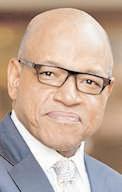
David A. Thomas
The mission of The Consortium is to enhance diversity in business education and leadership by helping to reduce the serious underrepresentation of African Americans, Hispanic Americans and Native Americans in its member schools’ enrollment and the ranks of management. The Consortium recruits for graduate business education qualified U.S. citizens and U.S. permanent residents who can demonstrate a commitment to The Consortium’s mission and can best assist The Consortium in pursuing this mission.
The Consortium recruits new member schools selectively. Georgetown is the first university to join the roster since 2010.
“We are excited to join the Consortium for Graduate Study in Management and work together to educate and expand the next generation of diverse business leaders,” said David A. Thomas, dean of Georgetown’s McDonough School of Business.
“Building a diverse student body enhances the educational experience in an organic way that supplements the knowledge taught by our professors and curriculum. As we prepare our MBAs to be principled leaders with a global mindset, it is essential that they view business through the lens of numerous cultures, backgrounds, and perspectives.”
The Consortium’s Board of Trustees chairman, Dean Paul Danos of Dartmouth College’s Tuck School of Business, said looks forward to collaborating with Georgetown.
“The addition of Georgetown marks a wonderful point in The Consortium’s history,” Danos said.
“Including an 18th member school shows how The Consortium continues to grow in breadth and prominence.”
Consortium member schools include University of California, Berkeley, University of California, Los Angeles, Carnegie Mellon University, Cornell University, Dartmouth College, Emory University, Indiana University – Bloomington, Georgetown University, University of Michigan, New York University, University of North Carolina at Chapel Hill, University of Rochester, University of Southern
American staff
Women-owned small businesses will have greater access to federal contracting opportunities as a result of changes included in the National Defense Authorization Act of 2013 (NDAA) to the U.S. Small Business Administration’s WomenOwned Small Business Federal Contract Program.
“Today, women own 30 percent of all small businesses up from just 5 percent 40 years ago,” said SBAAdministrator Karen Mills. “As one of the fastest growing sectors of small business owners in the country, opening the door for women to compete for more federal contracts is a win-win.”
The NDAAremoves the anticipated award price of the contract thresholds for womenowned small businesses (WOSB) and economically disadvantaged women-owned small businesses (EDWOSB) to allow them greater access to federal contracting opportunities without limitations to the size of the contract.
Prior to the new law, the anticipated award price of the contract for women-owned and economically disadvantaged women-owned small businesses could not exceed $6.5 million for manufacturing contracts and $4 million for all other contracts. The Women’s Federal Contract Program allows contracting officers to set aside specific contracts for certified WOSBs and EDWOSBs and will help federal agencies achieve the existing statutory goal of five percent of federal contracting dollars being awarded to WOSBs.
The law also requires the SBAto conduct another study to identify and report industries underrepresented by women-owned small businesses. As a result, more eligible women-owned businesses may be able to participate in SBA’s Women’s Federal Contract Program and compete for and win federal contracts. The SBAis working with the Office of Federal Procurement Policy under the President’s Office of Management and Budget on the implementation including changes to the Federal
Acquisition Regulations.
Every firm that wishes to participate in the WOSB program must meet the eligibility requirements and either selfcertify or obtain third party certification. There are four approved third-party certifiers that perform eligibility exams: El Paso Hispanic Chamber of Commerce, National Women Business Owners Corporation, U.S. Women’s Chamber of Commerce, and the Women’s Business Enterprise National Council. Additional information and links about approved third-party certifiers are available at www.sba.gov/wosb.
To qualify as a WOSB, a firm must be at least 51 percent owned and controlled by one or more women, and primarily managed by one or more women. The women must be U.S. citizens and the firm must be considered small according to SBAsize stan-
dards. To be deemed “economically disadvantaged,” a firm’s owners must meet specific financial requirements set forth in the program regulations.
The WOSB Program identifies 83 four-digit North American Industry Classification Systems (NAICS) codes where WOSBs are underrepresented or substantially underrepresented. Contracting officers may set aside contracts in these industries if the contract can be awarded at a fair and reasonable price and the contracting officer has a reasonable expectation that two or more WOSBs or EDWOSBs will submit offers for the contract.
For more information on the Women-Owned Small Business Program or to access the instructions, applications or database, please visit www.sba.gov/wosb.
California, The University of Texas at Austin, University of Virginia, Washington University in St. Louis, University of Wisconsin –Madison and Yale University. Founded in 1957, Georgetown McDonough is
home to some 1,400 undergraduates, 1,000 MBAstudents, and 1,200 participants in executive degree and open enrollment programs. Learn more at http://msb.georgetown.edu or on Twitter @msbgu.
For additional information regarding The Consortium for Graduate Study in Management, visit www.cgsm.org, call 1-888-3288414 or follow on Twitter @cgsm_mba.


American staff
AKirkwood man and East African native is quietly building his own version of the American dream, in part thanks to the Missouri National Guard.
First Lt. Pesseglou Yoma was born in Kadjanga, Togo and immigrated to the United States in 2004, armed with a college degree in economics.
“The State Department allows for 50,000 legal immigrants a year from various countries, and I applied for the program,” Yoma said. “When I was among those selected to immigrate to the U.S., I was happy, but I knew it would be a challenge. I had no knowledge of English.”
Yoma landed in St. Louis with the help of a college classmate who had married an American woman and was living in the area.
“The weather here was the real shock to me,” he said. “I will never forget in my life the first time I saw snow.”
As he predicted, Yoma’s inability to speak English was a serious setback to finding work, despite his education. Still, he was able to find employment.
“My first job was at Hardee’s,” he said.
Yoma eventually landed a job as a cook at Cardinal Glennon Children’s Medical Center, where a coworker spoke to him about the Missouri National Guard.
“I worked with a female soldier, and she had a new car and was going to school,” Yoma said. “I knew we weren’t making that much money, so I asked her how she could afford all this and that’s when she started talking about the National Guard. She told me the Guard paid for her schooling. Then she told me that I could be a soldier, too.”

Stunned by this revelation, especially since he was 38years-old, Yoma sought out a National Guard recruiter to get
American staff
Climate change is directly connected to human and civil rights, said Jacqui Patterson, director of the Climate Justice Initiative for the National Association for the Advancement of Colored People (NAACP). Patterson toured the campuses of Southern Illinois University Edwardsville and the SIUE East St. Louis Center as part of SIUE’s Earth Week activities this spring.
Patterson began her presentation by showing the inequities that exist for lowincome people and AfricanAmerican and Latino communities as it relates to climate change. It is these neighbor-
more information, but even that proved to be a challenge.
“Other than going to work, I had never ventured very far outside of Kirkwood, so I Mapquested directions to the recruiting office on Telegraph Road,” Yoma said. “Then I passed up the highway exit and had to go back, and then I passed up the recruiting office and had to turn back again.”
After visiting with the recruiter Yoma was given a series of tests and did well.
He enlisted in the Missouri Army National Guard in July 2007 and was eventually assigned to the 1035th Support Maintenance Company, headquartered at Jefferson Barracks.
Ayear later, Yoma was taking a break during drill, studying for graduate school, when a fellow soldier discovered he had a master’s degree.
“My friend suggested that I become an officer and took me to see the company commander,” Yoma said. “I no idea what that entailed at the time but I decided to apply for Officer Candidate School. That’s how I became an officer. Somebody else decided that I should be.”
Now the munitions officer for the 835th Combat
hoods, Patterson said, that are disproportionately negatively impacted and NAACPis working hard to help.
“We are doing this work for Latino and African-American children from the Bronx to Biloxi who are already in food deserts and will only suffer from less access to affordable nutritious foods as climate change drives shifts in agricultural yields,” Patterson said. “So in a land of abundance, we have whole communities whose rights to clean air and water, uncontaminated land and nutritious foods to eat are being violated on a daily basis.”
The NAACPdirector went on to point out some energy production processes that have
devastating effects for some people.
There are 378 coal fired power plants in crowded areas across the U.S., Patterson noted.
“These plants that are spewing mercury, arsenic, lead, sulfur dioxide, nitrogen oxide, as well as carbon dioxide,” she said, “are primarily in communities of color and lowincome communities.
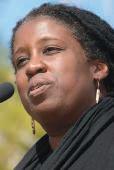
“With African-American families more likely to live next to a coal-fired power plant, we have AfricanAmerican adults more likely to die from lung disease but less

likely to smoke. We have AfricanAmerican children who are three times more likely to be admitted to the hospital for asthma attacks and twice as likely to die from asthma.”
But there are things that can be done, Patterson said. The public can hold the government responsible for the commitments it has made such as advancing a clean energy standard of 80 percent of renewable energy by 2050 and developing a climate action plan by the end of 2013.
“There is an African
proverb that says: ‘When spiders unite, we can tie up a lion!’” Patterson said. “’If we come together, we can advance living in harmony with Mother Earth as well as each other.”
SIUE Chancellor Julie Furst-Bowe touted some of SIUE’s strides and advances in the area of sustainability and introduced Patterson as the guest speaker at the Diversity and Sustainability presentation on the Quad.
“The university has been involved in activities that enhance sustainability for quite a while, even before the term ‘sustainability’became popular,” Furst-Bowe said. “So, we are a trend setter.”
Sustainment Support Battalion in Jefferson City, Yoma believes the National Guard gave him the foothold in American society he needs to be successful. In addition to speaking very good English, Yoma is now married and has a young son. He also maintains two civilian jobs, cooking at Cardinal Glennon and stocking shelves at Sam’s Club.
“I’ve discovered that it’s not so much what you do, but how you do it,” Yoma said. “If a job is worth doing, it’s worth doing well.”
For more information about the Missouri National Guard, please visit www.moguard.com.
“There is an African proverb that says: ‘When spiders unite, we can tie up a lion!’”
– Jacqui Patterson, NAACP
But communities like East St. Louis need to be part of the discussion of diversity and sustainability, Furst-Bowe continued. “East St. Louis has a longer path to go than many other communities,” said the SIUE chancellor, “but it also has resources that are unique to the area and could be utilized in ways that lift the community to greater levels of achievement.”
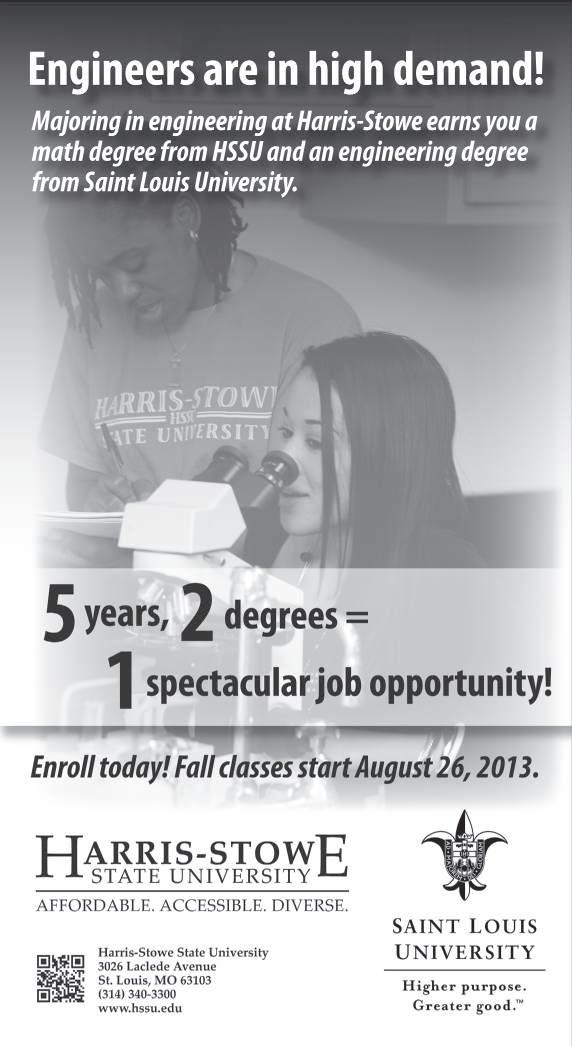
American staff
Lamell McMorris, has been appointed chairman of the National Diversity Advisory Council (NDAC) of the American Red Cross.
McMorris, the founder and CEO of Perennial, a Washington, D.C.-based family of businesses, will fulfill a one-year term.
McMorris was recommended by Floyd W. Pitts, Red Cross senior vice president and chief diversity officer, and approved by the organization’s Board of Governors.
“I am excited and humbled by the trust and confidence that Chairman Bonnie McElveen-Hunter and the Board of Governors have placed in me,” stated McMorris.
“My task is to serve as a bridge, to help Pitts in his efforts to connect principles of diversity and inclusion to the mission and business objec-
tives of the American Red Cross.”
Based on the principal that diversity and inclusion are achieved by aligning diversity efforts with organizational business objectives, the NDAC advises Red Cross leadership on relevant issues, and assists the organization through critical analysis and recommendations on various diversity initiatives, identification of best practices, and progress assessment reports.
“We are fortunate to have someone of Lamell’s caliber appointed as our new Council Chairperson because he brings to our efforts substantial expertise in working with non-profits and a history of forward thinking,” said Pitts. “Over the years, Lamell has developed deep and sustained relationships with influential leaders and decision makers across a wide range of constituencies.”
Among those leaders is Reverend Al Sharpton, president of National Action Network and host of MSNBC’s PoliticsNation.
“The appointment of Lamell McMorris, a proven leader and advocate for social justice, and one of the brightest stars on the horizon in business, is a serious statement that the American Red Cross intends to build a bridge and foundation for the future,” stated Sharpton.
“This is a very positive step and will be very well received by my colleagues in the civil and human rights community.”
stated.
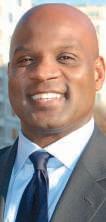
Marc Morial, president of the National Urban League and former mayor of New Orleans, praised the American Red Cross for choosing a leader with a track record of delivering.
“I’ve seen devastation like never before and I’ve experienced firsthand the challenges of bringing resources to communities hit hard by a natural disaster. In those moments you need friends and leaders in position who can deliver,” he
McMorris, a native Chicagoan, moved to Washington, D.C. in 2002 to open Perennial Strategy Group, a strategic advisory firm that provides government relations and public affairs services to Fortune 500 companies, national non-profits, trade associations, and public-sector clients on a wide range of publicpolicy issues and corporate matters. McMorris launched Perennial Law Group and Perennial Sports and Entertainment shortly thereafter, which collectively represent a number of wellknown entertainers and dozens of professional athletes.
In this capacity, McMorris has partnered with corporations and interest groups located in areas prone to natural devastation. One of the largest corporate foundations
in the state of Alabama, the Alabama Power Foundation, is frequently called upon to support relief efforts and other initiatives focused on stabilizing Alabama communities after a natural disaster.
“The appointment of Lamell McMorris is a serious statement that the American Red Cross intends to build a bridge and foundation for the future.”
– Rev.Al Sharpton
“In most of these cases, there’s no better partner than the American Red Cross,” the foundation’s president, John Hudson, said. “Because of our experiences working with Lamell on local and national community initiatives, we have extreme confidence in his leadership and ability to help strengthen our partnership and the communities in our state.”
Also endorsing the move is Curley Dossman, chairman
of 100 Black Men of America. He states, “Appointing Lamell McMorris to the helm of the NDAC is an affirmative move in empowering our most vulnerable communities as they embrace the American Red Cross’ life-saving message. Lamell’s very makeup is humanitarian in nature, and I’m confident that his fearless advocacy of the welfare of others will have a significant and lasting impact on the council’s mission.”
James Crowell, fellow National Association for the Advancement of Colored People (NAACP) board member, and president of the Biloxi, Mississippi Chapter of the NAACP, is no stranger to the devastation caused by natural disasters.
“He will work tirelessly to build upon the efforts that have been initiated and will bring enthusiasm and ingenuity to the council and the entire mission of the organization,” Crowell said of McMorris.

AARPCEO A. Barry Rand
is featured in THE NETWORK: Portrait Conversations, a new book and video portrait collection unveiled late last year at the National Portrait Gallery in Washington, D.C. THE NETWORK, created by artist Lincoln Schatz, whose Esquire Magazine
Schatz’ 89 portrait subjects also include U.S. Supreme Court Justice Sandra Day and civil rights activist Vernon Jordan.
“Portrait of the 21st Century” won him critical acclaim, offers a stunning and unique portrayal of contemporary American leadership and innovation.
Filming each portrait with multiple cameras during a 45minute conversation, Schatz captured each subject as they discussed their legacies, accomplishments, and aspirations.
Working with this footage, Schatz used custom software to recombine the video based on topic – what he refers to as “the generative portrait” process.

Rand, a dynamic leader and change agent, joined AARPas CEO in 2009 and also serves as chairman of the Board of Trustees at Howard University.
mission in his video portrait.
“Baby boomers are looking around and asking, ‘What do I do next? What’s my purpose? How do I take advantage of these incremental years that everybody’s telling me I’m supposed to have?’” Rand says, reflecting on AARP’s
“Our challenge is to take this growing population and help them do what they want to do, which is to find purpose, to find how they’re going to live their lives, to let them understand what this means to their kids and grandkids”
While the National Portrait Gallery presentation show-

cased sections from each video portrait, the book features stills from Schatz’s unique portraiture process and includes exclusive personal essays from each subject.
Representing government, business, science, technology, nonprofits and culture, Schatz’89 portrait subjects
also include U.S. Supreme Court Justice Sandra Day O’Connor, Emmy Awardwinning journalist Cokie Roberts, Republican strategist Karl Rove, and lawyer, businessman and civil rights activist Vernon Jordan.
“AARPis focused on how we can help and what we will do to help,” Rand says in his video portrait. “In the next couple of years, there are going to be some really big challenges.”
For more information about THE NETWORK: Portrait Conversations, visit the Lincoln Schatz Studio at http://thenetworkportrait.com/.

American staff
Ameren Missouri’s Shirley Stennis recently received the “Authentic Leadership Award” from the Ameren Network of Minority Employees (ANME), which is one of the company’s employee resource groups.
Stennis, managing supervisor of Business and Community Relations, was recognized “for making others around her better, challenging them to do their best and treating everyone with respect,” according to a release.
“If everybody gives, then everyone receives.”
– Shirley Stennis
“Shirley’s leadership style has a positive effect on others,” said Clay Doze, a corrective action specialist and current president of ANME.
“So many people have been inspired by Shirley or something that she has said or done. She is tremendously passionate about helping people reach their full potential. Our company, as well as those who know and work with Shirley, have benefited greatly from the authenticity and genuineness that she displays each day in the workplace.”
On hand to present the award were Thomas R. Voss, president and CEO of Ameren Corp., and Richard Mark, president and CEO of Ameren Illinois. They were joined by

Sharon Harvey Davis, chief diversity officer of Ameren Corp., Mark Lindgren, chief of human resources of Ameren Corp. and members of ANME during a special program at the company’s corporate headquarters.
“Receiving this award is the most humbling experience in the world because it came from my colleagues,” said
Stennis, who has worked for the company for 30 years.
“I’m truly honored to be recognized as an authentic leader.”
For the majority of her career, Stennis has worked in customer service for commercial, industrial and residential customers. In her current role, she supervises a team of key account executives, who serve

as liaisons for Ameren Missouri’s large commercial and industrial account holders. She also supervises a team of business and community affairs coordinators, who manage relationships with 91 municipalities served by Ameren Missouri.
Stennis has twice served as president of the ANME and takes great pride in assisting
with mentoring at Ameren Missouri. She is very passionate about sharing her knowledge, helping others and bringing people together from different parts of the company. Often, during conversations, Stennis asks one simple question: “What legacy will you leave?”
“If everybody gives, then everyone receives and that makes the company better, which is what we should all want.”
In 2012, Stennis received the Thomas R. Voss, Diversity Excellence Award and the Corporate Hero Circle for Cancer Award.
“As employees, it’s important to make things better for the next generation,” she said.
